On-Prem vs. Cloud-Based: Choosing the Best Deployment Model for Workspace Systems
On: November 12, 2025
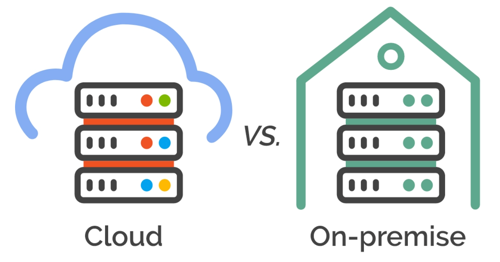
If you're in IT and evaluating how to roll out meeting room tablets across your offices, one question should arise early: Where will this system reside?
Not physically, the tablets are taken outside the rooms, clearly. But behind every display that shows meeting status, handles booking requests, and pulls data from your calendars, there’s a central hub doing the heavy lifting: the server.
And how you deploy that server, whether on your premises, in the cloud, or a hybrid setup, shapes how reliable, secure, and scalable your meeting room solution will be. This is where your IT teams can make or break the deployment.
We will break down the most common server deployments (on-premise, cloud and hybrid) so that you can know what is the best solution for your environment
What Is an On-Premise Server Deployment?
On-premise deployment means your workspace software’s server is hosted locally under your control. In this model, the room booking or desk booking system’s backend is installed on servers that your organisation owns (or leases) and manages, often at your office or data centre. All the software, databases, and data reside on your company’s infrastructure. Typically, your IT team is responsible for setting up, updating, and maintaining these servers and keeping the system running smoothly. This gives you full control over the environment; you can configure hardware, security, and integrations to suit your needs.
However, it also means all upkeep falls on your team, from applying patches to handling any hardware issues or capacity upgrades. In practice, an on-prem deployment for a room or desk booking tool might involve installing the server software on a local Windows or Linux server (physical or virtual) within your network, connecting it to your internal calendar system (like an on-site Exchange server), and managing access for employees within your firewall.
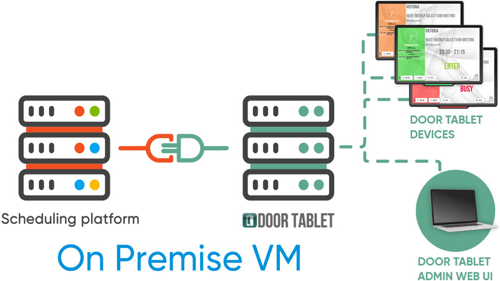
What Is a Managed Cloud Server Deployment?
A cloud deployment means the workspace tool’s server runs on a provider’s cloud infrastructure rather than on hardware you manage. In this model, your room/desk booking system is delivered as a service by the vendor over the internet. The software and data are hosted off-site in the vendor’s cloud (for example, on AWS or Azure data centres) and accessed via web or app clients. You don’t need to set up a server yourself – the provider handles the heavy lifting of provisioning and maintaining the servers. Your organisation’s devices and browsers simply connect to the system through an internet connection. This makes deployment much quicker (often just signing up and configuring settings) compared to procuring and installing your own server hardware. It also means your IT team isn’t on the hook for things like server updates or backups – the cloud vendor manages those.
The trade-off is that you are relying on external infrastructure: your data is stored in a third-party data centre, and you access the tools over the internet instead of your local network. For example, a cloud-based desk booking system might be hosted on the vendor’s multi-tenant platform online. You’d simply log in through a web portal or app, and all your offices would use that centralised service without any local server installation.
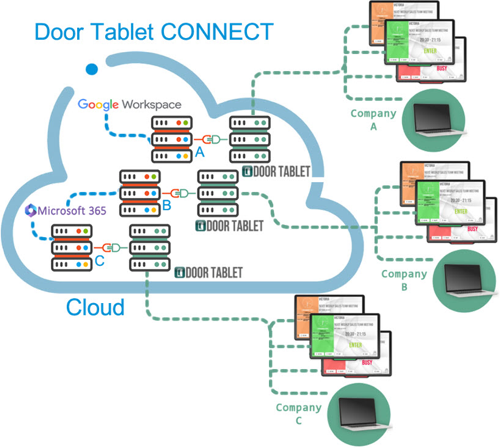
Self-Managed Cloud Deployments
A self-managed cloud deployment offers a middle ground between full vendor-hosted cloud services and on-premise infrastructure. In this model, the server software is deployed in a cloud environment controlled by your organisation, such as your own AWS, Azure, or Google Cloud account. While the server is hosted in the cloud, your IT team retains control over its configuration, security, updates, and data. This setup provides flexibility in terms of where and how the system runs, while still offering the scalability and geographic reach of cloud hosting.
It is especially useful for organisations that already maintain a robust cloud environment and prefer to keep server management in-house without the physical hardware constraints of on-premise setups.

Comparing On-Premise, Multi-Tenant Cloud, and Self-Managed Cloud: Advantages & Disadvantages
Now that you have a better understanding of what on-prem and cloud deployment mean. Let’s go over how on-premise and cloud deployments stack up in key areas important to IT teams, from maintenance to user experience:
1. Maintenance & IT Overhead
On-premise systems require in-house upkeep. Your team handles everything, like installing updates, applying security patches, monitoring performance, and fixing issues on the server. This can be labour-intensive and demands specific expertise (or dedicated staff) to manage the infrastructure.
In a multi-tenant cloud model, much of that headache is lifted. The vendor takes care of server maintenance and software updates centrally, so you always run the latest version without manual intervention. There’s no server hardware for you to patch or power, freeing your IT staff to focus on other tasks.
With a self-managed cloud deployment, your IT team is still responsible for maintaining the server, but without the physical infrastructure. You control updates, backups, and availability using cloud tools and best practices.
The flip side of both cloud models is less direct control over infrastructure-level customisation compared to on-premise deployments.
2. Performance & Reliability
With on-premise deployments, your system is running on the local network, which can mean low latency and fast response times for on-site users. If your booking system needs to interact with other on-site services (like a local Exchange calendar or building access control), keeping it on-prem can minimise any network lag.
On-prem systems can also keep running even if your external internet connection goes down – employees on the local network might still be able to use the tool if it doesn’t rely on outside data.
Cloud systems, on the other hand, are engineered for high availability across regions. A good cloud provider will use scalable infrastructure and redundancies to ensure uptime and speed globally. Internet connectivity is the linchpin for cloud performance – a strong connection makes the experience seamless, but an outage can temporarily hinder access.
In terms of reliability, cloud providers often boast uptime SLAs (Uptime Service Level Agreement) and rapid failover capabilities that would be expensive to replicate on-prem. On-prem reliability rests on your redundancy planning; you might implement backup servers or failover clusters, which add complexity. In short, on-prem can offer speedy local access and offline capability, while cloud offers robustness and scale, but relies on that network link.
Self-managed cloud servers sit somewhere in between. You can select the geographic region, configure redundancy and backups, and scale performance settings as needed. This gives more flexibility and ownership than a multi-tenant cloud, but you are responsible for uptime.
3. Scalability & Growth
Cloud-based deployments make it easy to roll out your meeting room booking system, hot desking tools, or wayfinding screens as your offices grow. If you're expanding into a new floor or adding 100 desks across regional hubs, you don't need to rethink your infrastructure. Just configure the new devices, connect them to the cloud instance, and you're good to go. Cloud models scale on demand, so whether you're onboarding ten users or a thousand, the backend adjusts automatically. This flexibility is especially valuable for hybrid workplaces where occupancy changes week to week, or for companies piloting workspace tools before rolling them out more broadly. On-premise scaling is still possible. It just requires more internal effort. Adding more rooms or users could mean provisioning extra server capacity, increasing database throughput, or implementing failover clustering. These things aren’t insurmountable, but they take time, budget, and planning. For IT teams used to building out infrastructure in-house, that’s manageable.
For those looking to deploy quickly or scale dynamically across distributed locations, the cloud offers a clear advantage. Self-managed cloud also supports elastic scaling, but your team needs to plan, monitor, and manage provisioning across your cloud account. This makes it a good fit for organisations with in-house DevOps or IT capabilities who want more control without physical limitations.
4. Integration & Customisation
Workspace tools don’t live in a vacuum. They have to integrate with calendars, identity providers, sensor platforms, and sometimes legacy systems. If you're self-hosting the server, you're in control of the environment. That means you can build connections to your internal room booking policy engine, legacy HR system, or access control platform using custom scripts, direct database access, or internal-only APIs. In cloud deployments, integration depends on the APIs the vendor supports. For common platforms like Microsoft 365, Google Workspace, or Azure AD, most cloud systems have turnkey connectors. But if your estate includes bespoke or older systems, or if you want to enforce hyper-specific business logic in your room booking flow, on-prem is usually more adaptable. That’s not to say cloud can’t be extended; many vendors, Door Tablet included, provide API access and optional modules, but the sandbox is wider when the server is in your own hands.
Self-managed cloud gives you a hybrid level of flexibility. Since you control the hosting environment, you can implement more advanced integrations than with a multi-tenant cloud, while still enjoying the benefits of cloud scalability and remote access to all modules, but the sandbox is wider when the server is in your own hands.
5. Security Considerations
Data Residency & Compliance
Security is one of the biggest deciding factors in deployment strategy—especially when you're dealing with room booking data, employee check-ins, or guest access logs.
With on-premise deployments, you maintain full control over data location, encryption, and access. This is essential for organisations in highly regulated sectors (finance, healthcare, government) or those using platforms like Microsoft 365 GCC High, where data must remain within specific boundaries. You know exactly where your server is, how it communicates, and which logs are stored—and you can audit every part of it.
Self-managed cloud deployments provide more flexibility than vendor-hosted solutions while still offering strong control. You decide which region the server is hosted in (e.g., EU, UK, or US), manage your own security configurations, and can meet many regulatory standards by enforcing your own encryption and access protocols. However, your team is still responsible for maintaining compliance—unlike on-prem, you're also relying on a third-party cloud provider (e.g., AWS or Azure) for underlying infrastructure compliance.
Multi-tenant cloud deployments (like Door Tablet CONNECT) offer the least customisability but come with out-of-the-box security managed by the vendor. The provider takes care of hosting, updates, backups, and general infrastructure protection. This is ideal for organisations without complex compliance requirements, but it may not satisfy teams with strict data sovereignty rules or government-grade mandates that prohibit third-party managed environments.
Network Access & Exposure
On-prem servers live behind your own firewall, which limits internet exposure by default. If configured correctly, only internal users or those with VPN access can connect. This creates a closed, tightly controlled environment.
Self-managed cloud offers global accessibility with security depending on how well your team configures access protocols, such as firewalls, IP whitelisting, and user-level permissions. You can replicate on-prem-like controls, but it requires active management.
Multi-tenant cloud is accessible over the public internet by design. Vendors enforce strong encryption and offer compliance certifications, but the exposure surface is inherently broader, and organisations must be comfortable with handing over part of that responsibility.
Administrative Control & Responsibility
On-prem gives you full administrative access; you own the stack and manage everything from OS patches to user permissions. It’s ideal for organisations that want to tailor every aspect of their environment and aren’t afraid of that responsibility.
Self-managed cloud splits responsibility. You control the server software, security settings, and data handling, but your cloud provider (e.g., AWS) manages the physical infrastructure and uptime. This gives you significant control without needing a data centre.
Multi-tenant cloud offers the least administrative access, but that’s part of the appeal. The vendor manages the entire environment, ensuring updates, uptime, backups, and security patches are handled automatically. This significantly reduces internal IT workload and ensures best practices are followed consistently. While it limits low-level customisation, most organisations benefit from the streamlined setup, predictable performance, and quick deployment, especially when speed and simplicity are key.
Many cloud providers have robust security protocols and undergo independent audits, often achieving high compliance standards that individual companies would find costly to attain. Still, some organisations remain wary of trusting a third party with critical systems or data. Highly regulated sectors like government agencies or those with unique security needs might lean toward on-prem for the peace of mind of having the server under lock and key (both figuratively and literally).
Door Tablet: Flexibility with Cloud and On-Premise Options
When it comes to workspace management solutions, Door Tablet recognises that one size doesn’t fit all. IT teams have varying infrastructure preferences and requirements, so Door Tablet provides all three deployment models to suit modern IT environments: on-premise, self-managed cloud, and multi-tenant cloud.
If you prefer a cloud-hosted service, Door Tablet CONNECT is available as a secure, multi-tenant cloud solution running on AWS. With Door Tablet CONNECT, you don’t need to provision any servers yourself; our team hosts and manages everything, allowing you to get up and running in minutes once your instance is provisioned. This is ideal if you want to minimise maintenance and let the vendor handle updates and scaling.
On the other hand, Door Tablet also offers an on-premise server version for organisations that require everything to be on-site. In this model, you can run the Door Tablet server software on your own Windows PC or virtual machine in your data centre. This gives you full ownership of the system’s environment, which can be advantageous for high-security deployments or situations with limited internet connectivity.
Door Tablet’s on-prem solution isn’t limited to physical servers on your premises – you can also deploy it in your private cloud (for example, on a company-controlled AWS or Azure VM). This self-managed cloud option means you still own and control your server instance, but it’s hosted on the cloud infrastructure of your choosing. It combines the dedicated control of on-prem with the geographic flexibility and scalability of the cloud.
Door Tablet even makes it possible to migrate between server types if your needs change over time. For instance, an IT team might start with Door Tablet CONNECT for a quick pilot, then move to an in-house server later on, or vice versa. Few vendors support such seamless transitions – it’s a reflection of Door Tablet’s commitment to accommodating diverse IT strategies. Whether you want the simplicity of a cloud service, the control of an on-prem system, or a mix of both, Door Tablet’s architecture has you covered.
This flexibility means you won’t be locked into one deployment model; instead, you can align the system with your organisation’s evolving requirements.
Key Takeaways: Which One Should You Choose for Your Workspace Management System?
- On-premise servers are ideal for organisations with high security and compliance requirements, such as those using Microsoft 365 GCC High, who need full control over data flow, infrastructure, and hosting.
- Multi-tenant cloud (like Door Tablet CONNECT) is the fastest to deploy and requires the least internal maintenance, making it perfect for teams seeking a vendor-managed, low-touch solution.
- Self-managed cloud offers the flexibility of cloud infrastructure with the control of on-prem. Best suited for IT teams who want to manage their own environment but avoid physical server constraints.
- Hybrid and scalable: With the right platform, you can start in one mode and shift to another as your needs evolve, whether scaling across regions or increasing security requirements.
- Integration matters: On-premise gives maximum flexibility for integrating with legacy systems. Cloud (especially self-managed) supports modern APIs and rapid deployment across multiple locations.
- Security and control vary: All models can be secure. The difference lies in who manages the environment and how much responsibility your IT team is willing to take on.
Choosing What’s Best for Your Organisation
Ultimately, the decision between on-premise and cloud comes down to what fits your organisation’s needs and resources. Both models can successfully power modern room booking or desk booking systems; the key is to match the technology to your internal capabilities, compliance requirements, and plans.
The good news is that you don’t have to make this choice in the dark. It’s wise to evaluate both options in practice. Door Tablet allows you to do exactly that; you can spin up a live cloud demo or install a trial server on your network to compare the experiences side by side. Seeing the system in action will help determine which deployment model delivers the user experience and administrative comfort your IT team is looking for.
Friendly tip: Whichever route you lean toward, involve your stakeholders early; from security officers to end-users to gather input and address concerns. And don’t hesitate to take advantage of free trials or demos. With a hands-on trial, you’ll be well-equipped to choose the deployment strategy that makes your workplace run smoother and more securely.
Here’s to finding the perfect fit for your team’s workspace management needs!
How to Set Up a Downsized Office for Peak Performance
On: October 17, 2025
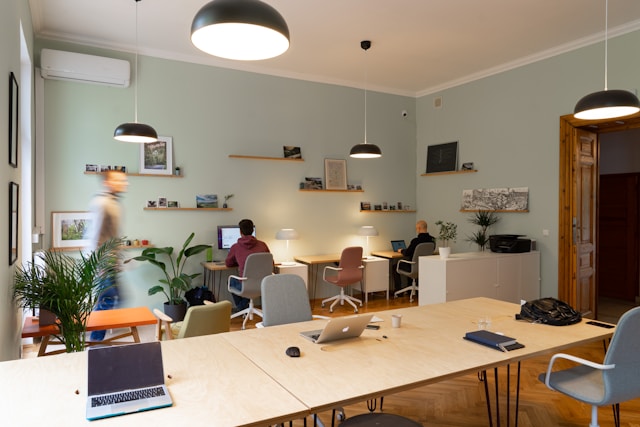
Your company just gave up the 30,000-square-foot headquarters that once held rows of empty desks and echoing hallways. Now you’ve moved into a 12,000-square-foot space, closer to public transport and sized for a hybrid team. The move makes financial sense, but as boxes get unpacked and teams settle in, the question hits:
how do you make this smaller office feel like an upgrade, not a downgrade?
This is where many companies find themselves in 2025. Downsizing is smart, but a tighter footprint demands smarter design. The goal is to
make every square metre count, ensuring employees still have room to collaborate, focus, and even unwind. Below are five practical ways to set up a downsized office that feels bigger, more comfortable, and truly fit for your company’s work style.
1) Get the mix right: less “me” space, more “right-sized” we-space
Before you buy a single chair, decide what your office is for—by day, by team, by activity. The most effective workplaces are shifting from rows of assigned desks to a balanced, activity-driven mix of spaces.
CBRE’s latest global workplace benchmarking shows seat-sharing is up, individual space has declined since 2021, and companies are deliberately growing collaborative and amenity space to match hybrid patterns. In 2024, 62% of organisations targeted ≥1.5 people per desk, and assigned seating fell from 83% to 55% of projects.
What that means for a smaller office:
- Plan for peaks, not averages. If Tue–Thu are busy, capacity-plan for those days, not the weekly mean. Use a sharing ratio (e.g., 1.6–2.0 people/seat) to right-size the desk count.
- Favour small rooms over big boardrooms. Convert one 12-person room into two 4-person rooms plus a phone booth; this aligns better with hybrid meeting patterns and cuts “one-person in a big room” waste. (Gensler’s 2023 survey shows people say they’d be more productive with the right variety of spaces, not necessarily more space.)
- Treat the office like a product. Baseline, release small changes, re-measure monthly. CBRE notes the shift to effectiveness metrics (not just density) and the importance of ongoing tuning.
2) Plan with real demand data and make availability obvious
Under- or over-building rooms is expensive.
The U.S. Government Accountability Office found that 17 of 24 federal HQs were at
25% or less of capacity during sampled weeks in early 2023, which is an expensive mismatch of supply and demand.
What to do:
- Instrument your patterns. Combine badge data, calendar bookings, and Wi-Fi presence to see who comes in, when, and for what. CBRE finds that organisations are increasingly using reservation and Wi-Fi data (and sensors selectively) to inform space decisions.
- Surface availability at the door. Put booking displays outside rooms and on wayfinding screens so people can book on the spot. Door Tablet supports meeting room signage, hot-desk booking, and wayfinding with native calendar integrations (Microsoft 365, Google Workspace, etc.), which is exactly the kind of visibility a compact office needs.
3) Make small feel big: sightlines, light, materials, and ceilings
A 2024 study in
Frontiers in Psychology showed that
view access, view content, materiality, and ceiling geometry all influence how roomy a space feels, validated with eye-tracking and VR. Another 2024 study in
Building & Environment found that
ceiling height significantly affects perceived spaciousness and arousal.
Design moves that punch above their weight in a downsized office:
- Open your sightlines. Keep tall storage on perimeters; use glass fronts on small rooms (with proper acoustic seals) to borrow light without adding noise.
- Lift the room visually. Lighten ceilings and upper walls; use continuous planes and uplighting to “raise” perceived height when you can’t move the structure.
- Pull people to the glass. Put touchdown seats and small rooms near windows; push storage/internal support spaces inside the floorplate. Studies consistently link window size and view quality with higher perceived spaciousness and psychological benefits.
- Use the right materials. Lighter palettes and low-visual-noise finishes expand perceived volume; layer texture where you want intimacy (library corners) rather than across the whole floor.
4) Protect brains first: air quality and acoustics in tight quarters
Air quality. A
2023 meta-analysis in Building & Environment found that even
short-term indoor CO₂ exposure below 5000 ppm can impair complex cognition. A 2023 UCL intervention study showed that reducing
PM2.5 in offices improved several memory-related tasks. UK HSE guidance is clear: employers must ensure adequate ventilation and should assess and improve poorly ventilated areas. Build IAQ targets into your operating routine, not just your design spec.
Acoustics. Across more than
600 office buildings, acoustics (people talking, speech privacy, phones) was the
top source of dissatisfaction, and the problem intensifies when you shrink footage. Visual
and acoustic privacy underpin perceived effectiveness in activity-based workplaces.
How to apply without blowing the budget:
- Ventilation & filtration. Meet or exceed outdoor-air setpoints, add portable HEPA units in enclosed rooms, and consider simple CO₂/PM displays where it nudges behaviour and maintenance. Use HSE’s plain-English guidance to assess and fix trouble spots.
- Tip: If you install CO₂/Air quality sensors in your office, you can use dedicated Door Tablet devices in highly public spaces to indicate the air quality in the room
- A ladder of privacy. Add phone booths, 2–4-person enclaves, and a few 6–8 rooms so one-person calls stop hijacking big rooms. Treat small rooms like little studios: door seals, absorptive panels, and mics that don’t pick up the corridor. Evidence from activity-based office research shows that privacy conditions strongly shape user perceptions.
- Set etiquette with tech. Meeting room and Desk Booking displays + clear room naming (e.g., “Call” rooms) + short time slots help route noisy work to the right spot without a policy manual.
5) Make the commute “worth it”: quality, amenities, and seamless tech
Employees don’t judge your office by square footage; they judge whether it
helps them work.
Gensler’s 2023 U.S. survey highlights a productivity gap between how often people are in the office vs. how often they want to be there to be productive—better mixes of space and amenities close that gap. Leesman’s 2024 hybrid analysis (305k+ respondents) shows
86% of employees now work in more than one location; offices that support both focus and collaboration win more frequent use.
Read
this article to learn what the workforce expects from the office experience in 2025
What to invest in first:
- Hybrid-ready rooms. One-tap join, camera framing that suits small rooms, and decent acoustics, so in-office and remote colleagues feel equally included.
- Comfort layers that scale in small spaces. A few wellness nooks, real plants, and soft seating in the right spots do more than a giant café you no longer have room for. CBRE tracks a steady rise in amenity space since 2021.
- Clarity beats abundance. With a smaller footprint, knowing what’s free matters as much as having more. Door Tablet’s room and desk booking, wayfinding, and signage makes availability obvious and reduces ghost-room risk in peak windows.
The Bottom Line
An upgraded small office is one that sweats the details: it’s well-equipped, aesthetically pleasing, and tuned to employees’ needs. When people walk into a downsized office that has energetic collaborative zones, peaceful nooks, lots of light, and even a decent espresso machine in a cosy corner, it
feels like an upgrade, not a step down. They might even forget the old 30,000-square-foot echo chamber entirely. After all, it’s not the size of the office that matters; it’s how you use it, and how it makes your people feel.
Microsoft 365 GCC High Room Booking: Secure Integration with Door Tablet
On: October 8, 2025

When your work involves national security, every email, calendar invite, and shared file carries a higher level of responsibility.
Government agencies and the contractors who support them in defence, aerospace and intelligence operate under some of the strictest data security and compliance requirements in the world.
Sensitive designs, controlled technical data and confidential comms must be safeguarded at all times, with zero tolerance for exposure to unauthorised systems or personnel.
That’s why Microsoft 365 GCC High exists. In this article, we’ll explain what it is, who uses it, the compliance standards it meets, the compatibility hurdles that often come with it, and how Door Tablet delivers a secure, compliant way to manage meeting rooms in these environments, whether deployed on-premises or in the cloud.
What Is GCC High and Who Is It For?
Microsoft 365 GCC High (Government Community Cloud High) is a specialised, high-security version of
Microsoft’s cloud environment tailored for U.S. federal agencies and their contractors. In simple terms, it’s Microsoft 365 made for organisations handling sensitive government data. Typical users of GCC High include Department of Defence (DoD) contractors, aerospace and defence companies, intelligence community partners, and any organisation dealing with Controlled Unclassified Information (CUI) or export-controlled data under ITAR (International Traffic in Arms Regulations).
For example, a defence manufacturer or a federal systems integrator might opt for GCC High to ensure their data is protected to government standards.
Unlike the standard commercial Microsoft 365, GCC High is hosted in Azure Government data centres exclusively in the United States, with access restricted to screened U.S. citizens. This isolation is intentional; it creates a cloud environment where sensitive data can reside with the assurance that it’s staying on U.S. soil and handled only by vetted personnel, a necessity for things like
ITAR compliance and other federal security mandates.
In short, GCC High exists because regular commercial cloud services don’t fully meet the stringent regulations that U.S. defence and government work often requires.
Why Does GCC High Exist? (Compliance Matters)
For agencies and contractors handling Controlled Unclassified Information or export-controlled data, compliance with U.S. government regulations is mandatory. Frameworks like DFARS, ITAR and CMMC require strict controls that standard Microsoft 365 can’t fully meet. GCC High was designed to close that gap, delivering a secure cloud aligned with the highest federal standards:
- FedRAMP High – GCC High has been FedRAMP High authorised, meaning it’s approved for handling federal data up to the “High” impact level. (FedRAMP is a U.S. government program that sets security standards for cloud services.)
- DFARS 252.204-7012 / NIST 800-171 – Defence contractors must follow the DFARS clause requiring protection of CUI per NIST SP 800-171. GCC High helps meet these requirements by implementing about 75% of the NIST 800-171 security controls out-of-the-box. In practice, this makes it much easier to comply with the cybersecurity rules in DoD contracts.
- ITAR and EAR – These export control laws require that sensitive defence-related data (like design documents for defence articles) be accessible only by U.S. persons and kept in the U.S. GCC High was built with this in mind: all data stays in U.S. datacenters and is managed by U.S. Summit. In other words, GCC High is ITAR-compliant by design, allowing defence contractors to use cloud email, calendars, and files without violating export control laws.
- CMMC (Cybersecurity Maturity Model Certification) – Many contractors are preparing for CMMC 2.0, a new DoD cybersecurity certification. GCC High supports compliance at CMMC Level 2 and Level 3, which correspond to protecting CUI. If you need to be CMMC-certified, a GCC High environment can tick many of the required security boxes for you.
With these (and other) standards, GCC High enables organisations to utilise Microsoft 365 – including email, calendars, Teams, SharePoint, and more – in a manner that aligns with federal security requirements. If your agency or company handles sensitive DoD data, GCC High could be the only cloud option to stay compliant.
Life in the GCC High Environment: Common Tech Challenges
Operating in the GCC High ensures security and compliance, but it also presents some practical challenges. Because it’s a restricted environment, not every feature or third-party integration that exists in regular Microsoft 365 will work in GCC High.
Microsoft intentionally limits or delays certain functionalities in GCC High to reduce risk. For example, new Microsoft features often roll out later to GCC High, and some services like public phone calling plans in Teams aren’t available at all in that cloud. As a result, agencies can struggle to adopt common workplace tech if those tools can’t integrate with GCC High.
How does Microsoft GCC High integrate with Workspace Management Tools?
In a modern office, you might see tablets mounted outside conference rooms showing the room’s schedule and allowing employees to reserve space. A typical off-the-shelf room scheduling panel might rely on connecting to Microsoft’s commercial cloud or an external service – a setup that would violate GCC High data policies or simply not function due to access restrictions.
In GCC High environments,
meeting room scheduling must work entirely within the platform’s secure boundaries. Calendar data stays inside Microsoft’s U.S.-only, FedRAMP High–authorised cloud, and all connections must use GCC High–specific endpoints. Any scheduling system must authenticate and exchange data without routing through non-compliant public clouds or external servers.
This means solutions that rely on commercial Microsoft 365 APIs or third-party data handling are often ruled out.
How is Door Tablet Bridging the Gap for Secure Room Booking Tech?
Door Tablet is a meeting room booking display solution, essentially a tablet-based system that syncs with your calendars and shows room schedules – and importantly, it was designed with high-security environments in mind.
Since version 10.11.14, it has supported direct
integration with Microsoft 365 GCC High, allowing agencies and contractors to connect securely to GCC High calendars without routing data through non-compliant services. This capability has enabled deployments in defence, aerospace, and other sensitive government facilities, modernising scheduling while keeping all meeting data inside the approved cloud boundary.
Door Tablet lets you have the convenience of a smart room scheduling system while staying within your approved cloud environment.
From the user’s perspective, the experience is simple: check availability, book a slot, or view upcoming meetings directly on the panel outside the room. Behind the scenes, Door Tablet communicates in real time with your GCC High tenant (Exchange Online/Outlook), ensuring schedules stay accurate and compliant.
Crucially, data stays under the same compliance umbrella. Door Tablet doesn’t need to siphon your room schedule data off to an unknown third-party server just to display it; it connects directly to your Microsoft 365 GCC High service. This direct integration keeps meeting information within the authorised cloud boundary.
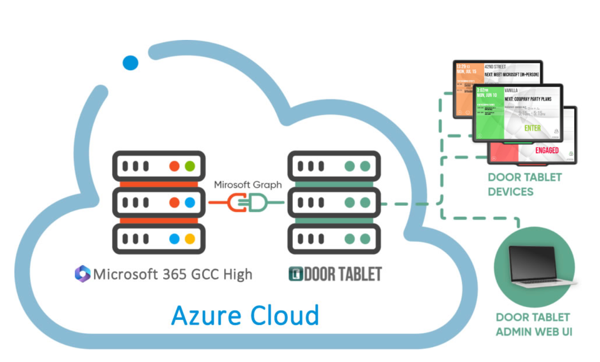
Flexible Deployment to Meet Your Security Needs
Every government agency or contractor has a unique IT setup and security posture. Recognising this, Door Tablet offers flexible deployment options to fit different needs, whether you want everything in-house or prefer a cloud service. Specifically, you can deploy Door Tablet in three ways:
- Door Tablet CONNECT (Cloud Service): This is a shared cloud-based server hosted by the Door Tablet team on AWS. They manage the infrastructure for you in a multi-tenant environment. Some government clients might not opt for this if their policies restrict using external cloud services that are not FedRAMP authorised. It’s a convenient choice for less restrictive environments or pilot programs, as a new instance can be launched in minutes once approved.
- On-Premises Server: For maximum security and control, you can run the Door Tablet server on your infrastructure. In this setup, all the Door Tablet data (like room names, bookings pulled from Exchange, device configurations, etc.) stays on servers you control. This is ideal for agencies that have a “no external cloud” policy or operate in air-gapped networks. The Door Tablet devices would then communicate with this local server to get calendar updates, which in turn communicate with your GCC High tenant (likely through your network’s secure connection to Office 365).
- Private Cloud Instance: A middle-ground option is deploying a dedicated Door Tablet server in a private cloud environment. This means you still run your own Door Tablet server software, but you might host it on a cloud platform that you control (e.g., Azure Government VM or AWS GovCloud instance). The Door Tablet endpoints (tablets, signage screens, etc.) communicate with this server in the cloud, which then talks to Microsoft 365 GCC High. Unlike the multi-tenant Door Tablet CONNECT service, this server is your instance, which can simplify compliance auditing. It’s essentially an extension of your network into the cloud, and you maintain control over it.
The
key takeaway is that Door Tablet doesn’t force a one-size-fits-all deployment, which is crucial for government and defence contexts. You can choose the model that aligns with your security team's comfort level.
Conclusion
Navigating the world of compliance can be daunting, but tools like Microsoft 365 GCC High exist to make it feasible to meet rigorous standards without halting your progress. GCC High provides the secure backbone for email, files, and collaboration in government and defence circles. Building on that backbone, companies are now creating
compliance-friendly workplace tech – proving that security and usability can coexist.
Door Tablet’s support for GCC High is a testament to this progress. It addresses a niche but important need (efficient meeting room management) in a way that respects the strict rules organisations must follow. For IT teams in the defence, aerospace, or intelligence fields, this should come as good news: you
don’t have to stick with whiteboards or old systems just because you have to follow rules like ITAR or CMMC.
You can modernise; you just have to modernise smartly, with the right partners and products.
Key takeaways:
- Microsoft 365 GCC High is designed for agencies and contractors handling CUI and export-controlled data, meeting strict standards like FedRAMP High, DFARS, ITAR, and CMMC.
- GCC High environments require workplace technologies, including meeting room scheduling, to operate entirely within secure cloud boundaries using GCC High–specific endpoints.
- Door Tablet integrates directly with Microsoft 365 GCC High, enabling secure, real-time room booking without routing data through non-compliant services.
We offer complete literature on integrating Microsoft 365 GCC High with Door Tablet.
Create an account to explore the full documentation and deployment guidance.
All the details you need for a thorough compliance review, in one place.
Why Meeting Room Tablets Are the Key to Smarter Workspace Analytics
On: September 25, 2025

How many of your meeting rooms sit empty on a Wednesday morning? Which ones are booked solid, but half the time no one shows up? Do people avoid that corner conference room because it’s too far from the lifts or because the air feels stale by 3 pm?
If you can’t answer those questions, you’re not alone. Too many workplace and IT teams are still making million-pound decisions based on complaints, gut instinct, or the occasional lap around the floor.
If you don’t have meeting room tablets, you’re guessing. You don’t know which spaces sit empty half the week or how many hours vanish into ghost bookings.
And if you
do have tablets? Chances are you’re only scratching the surface. Many organisations use them as glorified “booked/free” signs - helpful, but missing the bigger prize. Every booking, every no-show, every overrun or cancellation is data waiting to be captured. Tablets aren’t just signage; they’re analytics engines.
This article is about that untapped value. Why meeting room analytics matter more than ever, what they reveal about your space, and how the data hidden inside your tablets can turn guesswork into clarity.
1. You Can’t Fix What You Don’t See
Every conference room has a meeting scheduled on the calendar, yet you notice a few rooms are dark and empty. Is it a fluke, or a pattern? Without analytics, you simply wouldn’t know. This is the classic scenario of a
blind spot in workplace management. You can’t fix a problem you don’t see, and without data, a lot remains unseen. Many workplace teams rely on anecdotal feedback (“the large boardroom is always booked!”) or occasional headcounts, but lack hard numbers on how spaces are actually used.
For example, one
Gartner study revealed up to
30% of meeting room bookings are “ghost meetings,” reserved but with nobody showing up. That’s nearly a third of conference room time potentially wasted – a massive inefficiency that stays invisible if you’re only looking at calendars and not utilisation data.
In reality, sensors and utilisation reports often find a significant gap between bookings and actual usage, on the order of
20–30% in many organisations. Without shining a light on these no-shows, companies keep building more meeting rooms or assume space is fully utilised, when in fact a good chunk of reserved time is going unused.
Blind spots extend beyond ghost meetings. Consider space utilisation:
Is your average meeting room used 10% of the workweek or 50%?
It’s all too common for workplace leaders to
overestimate usage based on peak moments (“Every Tuesday at 11 am we’re packed, so all rooms must be heavily used”) or to
underestimate chronic issues (like one team monopolising a particular room). In a Leesman survey,
93% of real estate leaders said they measure basic office occupancy, but only 9% were using advanced sensor data for granular insights, which means most were likely missing the nuances in how different rooms and days are utilised.
You can’t manage what you don’t measure.
A facilities manager might sense that Fridays are quieter or that a certain floor’s meeting rooms are underused, but without numbers, it’s hard to justify changes.
You
could improve meeting room allocation, adjust cleaning and HVAC schedules to actual use patterns, or repurpose underutilised space… but only if you have the visibility.
The first step to improvement is acknowledging the need for visibility. This is where meeting room tablets come in, acting as a bridge between the physical workspace and digital analytics.
2. Meeting Room Tablets: The Data Behind the Display
When you see a tablet mounted by a meeting room door, you might think of it simply as a digital sign, a convenient way to display the room’s schedule or allow quick bookings. But modern
meeting room tablets are much more than glorified signs. They are, in fact, powerful data-gathering sensors and interfaces, the front door to a wealth of workspace analytics. These devices log every interaction: when a meeting is scheduled, when someone checks in, if a meeting ends early or overruns its slot, and when the room goes idle.
Many meeting room tablets also connect to
additional sensors. Motion sensors, for example, can detect whether people actually entered the room for a booked meeting. If the tablet doesn’t detect motion (or a manual check-in on screen) within a set timeframe, it can automatically mark the room as free again – essentially outing the ghost meeting and freeing the space for others.
In effect, the tablet is acting like a vigilant concierge, ensuring the schedule reflects reality. Without a tablet or sensor, a ghost meeting would go undetected (the room stays “booked” on the calendar while sitting empty). With a tablet, that ghost is busted, the room becomes bookable again, and the incident is logged in the data as a meeting that was booked but not attended.
Beyond motion,
consider environmental data. Many modern workplace tablets or their accessories can monitor conditions like temperature, humidity, air quality (CO₂ levels, VOCs), and light. Door Tablet, for instance, offers
health sensors that track CO₂ and air quality in each room. Why does this matter?
Because environmental comfort is a key part of workspace performance. If a meeting room is too stuffy or too cold, people will avoid it (or complain if they have to use it). In fact, temperature and air quality are consistently among the top workplace complaints -
surveys have found that temperature is the number one office complaint employees raise, often surpassing noise.
A
Harvard Healthy Buildings study found that
for every 500 ppm increase in indoor CO₂, employee response times slow by about 1.4–1.8%, with correspondingly lower cognitive performance. In practical terms, a poorly ventilated meeting room can literally make your team sluggish. A tablet tied into environmental sensors makes those invisible factors visible. You could use that data to adjust HVAC settings, add air purifiers, or simply understand why certain rooms get a bad reputation.
These meeting room tablets also serve a
dual role: not only gathering data, but also engaging employees to
influence behaviour. The tablet’s presence reminds people to check in for meetings (accountability), to free up the room if they finish early, or to book a space on the spot if they need one. Visual cues like the green/yellow/red availability lights instantly tell employees if a room is free without having to crack open a laptop. They even help prevent the age-old problem of conference room squatters or thieves – nobody wants to grab a room that’s clearly marked as reserved on the display for someone else’s meeting.
Knowing what to look for and what to do with it is where the magic happens, after all; capturing data is only half the battle. Let’s break down the specific metrics and insights that the best teams track once they have this data firehose open.
3. Making the Most of Door Tablet’s Embedded Analytics
Let’s zoom in on Door Tablet as an example of how embedded analytics in meeting room tablets work. Door Tablet is a conference room scheduling solution (with both software and supported hardware) that, beyond just facilitating bookings, provides a robust analytics component. If you’re already using Door Tablet, you might have heard about its Google Analytics integration or seen some of its dashboards. If not, this will still illustrate what a modern system can do.
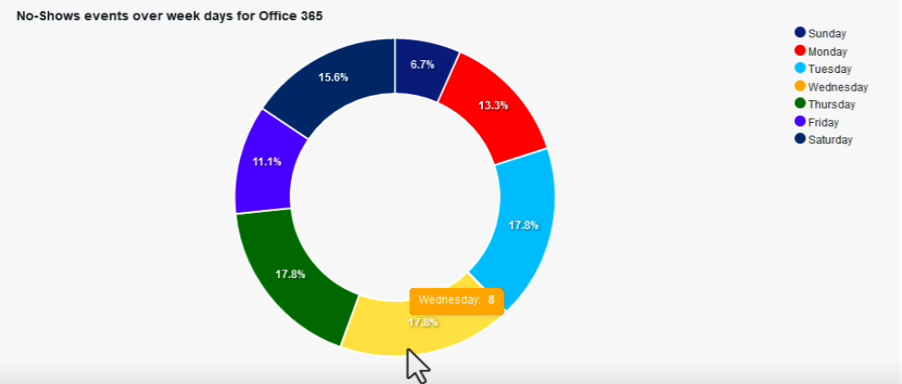 Chart showing weekly no-show meetings. Use Door Tablet to identify how many meetings are ghost meetings
Chart showing weekly no-show meetings. Use Door Tablet to identify how many meetings are ghost meetings.
Embedded Analytics: A standout feature of Door Tablet is its embedded analytics, meaning you don’t need to connect to an external platform like Google Analytics. From the moment the system is running, it automatically collects key statistics such as room utilisation, resource allocation, no-show rates, and even environmental data like air quality (if sensors are installed). Reports are instantly available with no set-up required, just choose the area you want to analyse and generate a chart. Because analytics are embedded directly into the platform, IT teams and facility managers can view performance metrics in real time without relying on internet connections or third-party tools.
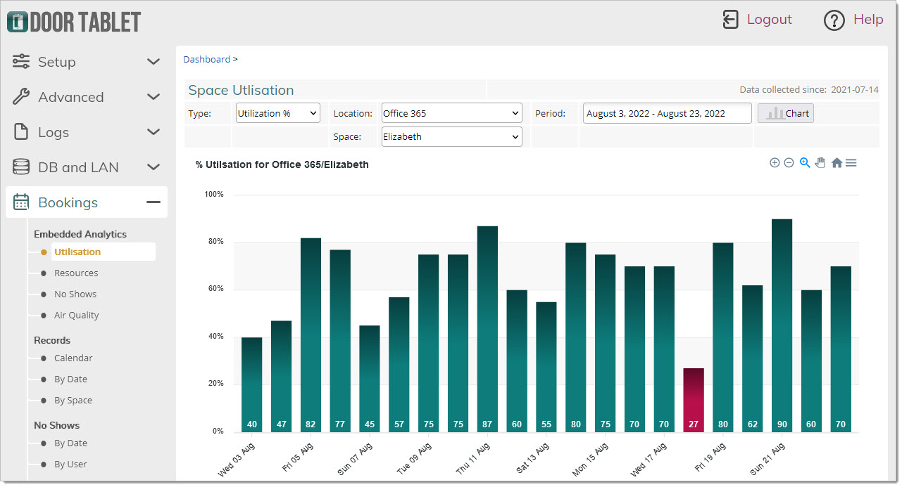
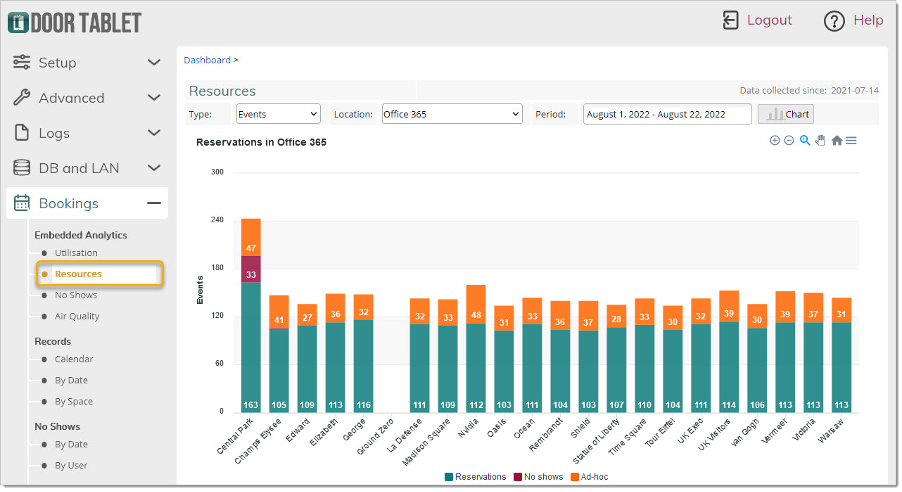 Dashboard Sample
Dashboard Sample
What Insights Does it Provide?
Once the data is flowing, what can you see? Door Tablet’s analytics are designed to answer exactly the questions we outlined in the previous section. The system can generate reports on all of the following and more:
- Room utilisation percentage: For each space, what percentage of bookable hours it’s actually occupied. For example, you might pull up a report and see: “Room 12A – 52% utilised last week, vs 47% the week before.” This helps track trends and identify under-/over-utilised rooms at a glance.
- Number of meetings aborted (no-shows): It explicitly counts meetings that were scheduled but never checked into. These would be the ones Door Tablet cancelled automatically for no-show or that were otherwise marked as not happening. You could rank rooms by no-show count or see how no-shows as a percentage of bookings change over time (perhaps after implementing new policies).
- Meeting duration distribution: The system can categorise your meetings by length – short vs. long. For example, it might show you that 40% of your meetings last 15 minutes or less, 45% are 30 minutes, 10% an hour, and 5% over an hour. This could validate if people are actually using the short meeting options or if everything defaults to an hour.
- Comparisons across spaces and locations: If you have multiple rooms, zones, or offices, the analytics will highlight which areas perform better than others. For instance, “Building A’s meeting rooms average 50% utilisation, whereas Building B (satellite office) only 20%.” Or at a micro level, “The 3rd floor rooms are used twice as much as the 2nd floor rooms.” Door Tablet even allows roll-ups by city or country, which is useful for global companies to see which offices have higher meeting density.
- Time comparisons: The platform supports month-on-month and year-on-year comparisons of utilisation. This is incredibly useful to spot seasonal trends (does usage dip in July/August and December? Likely yes) and to measure improvements after changes. If you undertake a “workspace optimisation project” in Q1 and then compare utilisation in Q2 vs. last Q2, you can see if the needle moved.
- Targets and benchmarks: Door Tablet can help you set a target (say, aim for 50% utilisation in all huddle rooms) and then identify which rooms are lagging (maybe a particular room is at 20%, flagging it for investigation).
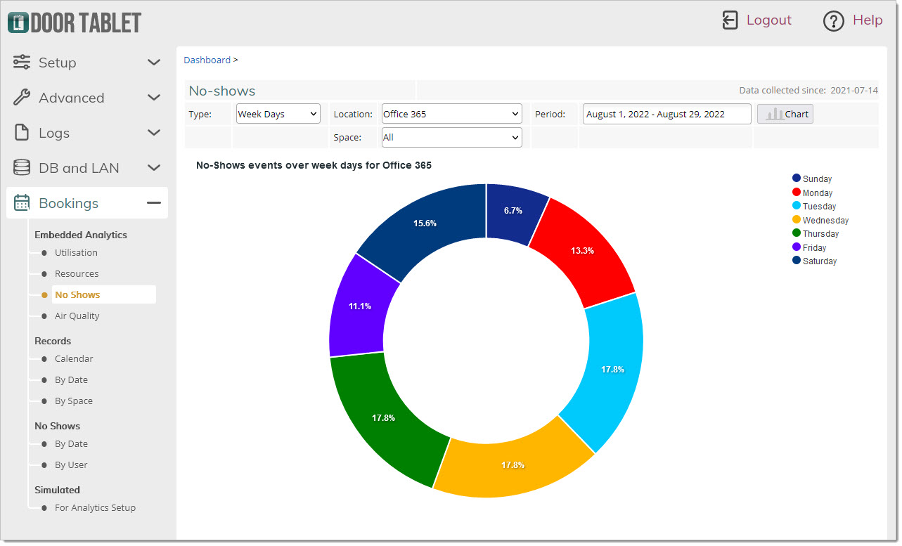 Dashboard Sample
Dashboard Sample
Tailoring Door Tablet to Your Workplace Needs
Making the most of embedded analytics also means configuring the system optimally. You decide what counts as a no-show (e.g., no check-in within 10 minutes), what the office’s bookable hours are, and how recurring meetings are handled.
One more cool aspect:
visualising environmental data alongside usage (optional). Door Tablet’s
sensor integrations mean you could potentially see a chart of CO₂ levels in a room throughout the day alongside its occupancy. For example, a conference room might show rising CO₂ during a long afternoon meeting, peaking above recommended levels, which correlates with participants reporting feeling drowsy. Having that chart empowers facility teams to intervene, perhaps by scheduling an extra ventilation flush at noon, or by limiting that room’s capacity for long meetings.
Conclusion: Goodbye Guesswork, Hello Clarity
Offices are too costly to run on gut feel. Meeting room tablets like Door Tablet turn opaque space usage into clear, actionable data. For teams without tablets, analytics should be the reason to start. For those already using them, the value lies in moving past “booked/free” and unlocking the insights already being collected.
Every underused room, every ghost meeting, every stuffy conference space is a solvable problem if you can see it. Analytics make that possible. The difference between guessing and knowing is the difference between wasted space and a workplace that works.
Key Takeaways
- Visibility is everything. Without analytics, up to 30% of bookings can be ghost meetings, wasted space that stays hidden if you only rely on calendars.
- Meeting room tablets are data engines. They capture utilisation, no-shows, duration, attendance, and even comfort levels, turning the invisible into clear insights.
- Track the metrics that matter. Utilisation rates, peak times, ghost bookings, meeting duration, and environmental comfort are the levers that help IT and workplace teams optimise space.
- Door Tablet helps you get started. Beyond dashboards and GA4 integration, Door Tablet offers a library of how-to videos so teams can learn step-by-step how to unlock analytics.
Interactive vs. Non-Interactive Displays: Choosing the Right Fit for Each Room
On: September 10, 2025

Selecting the right
meeting room booking display for your office means balancing functionality, reliability, and fit for purpose. Whether you deploy
interactive touch‑capable panels or
non‑interactive schedule signs, your choice will affect how teams locate, book, and manage meeting spaces.
In this guide, we’ll compare
interactive vs. non‑interactive displays, explore use cases across room types from small huddle spaces to boardrooms and coworking environments, highlight hardware examples our platform supports, and offer closing considerations to help your IT team make an informed decision.
What Defines Interactive and Non‑Interactive Door Tablet Hardware?
Interactive and non-interactive door tablet hardware both feature full-colour, customisable displays and connect seamlessly to the scheduling platform, but they differ in how people use them. Interactive Door tablet hardware often includes enterprise room‑panel devices (e.g. Door Tablet or Crestron TSS‑series) or consumer tablets (iPad, Android) mounted in custom enclosures. They let users view schedules, check in, book or release rooms, and even request support, right at the door. Most interactive professional panels also feature LED status indicators, visible from across a hallway.
Non‑interactive door tablet hardware, by contrast, is designed to display information only. These can be e‑ink (electronic paper) signs, interactive panels running in read‑only mode, or static LED strip indicators. They show room name, current meeting or status, and upcoming events, but do not accept touch input or enable booking on site. Some include colour LED bars or lights to convey availability at a glance.
Pros and Cons of Interactive Displays
Benefits of Interactive Hardware
- On‑device booking and check‑in: Users can reserve rooms, extend meetings, and check in directly on the panel, no phone or web access needed. This responsiveness is ideal for impromptu meetings or fast‑changing schedules. Many interactive panels also support automatic room release if no check‑in occurs within a defined window. That helps prevent ghost‑bookings and reclaims unused rooms.
- Live status indicators: Door Tablet’s purpose-built devices, such as the Door Tablet SL and Door Tablet NXT, feature integrated LED status bars that glow green when a room is free and red when it’s booked. These visual cues provide clear availability signals from a distance, making it easy to see whether a meeting space is in use before you reach the door.
- Rich, branded interface: Touch panels can show room details (name, capacity, amenities), custom backgrounds, logos, and multilingual prompts. Interface designs can support accessibility, and high‑contrast screens enhance readability. You can also run a slideshow during longer meetings, turning the display into a space for company updates, announcements, or branded messages, making the panel useful even when the room is occupied.
Considerations for Interactive Hardware
- Device management: Touch‑capable tablets and panels run operating systems (Android, iOS, proprietary firmware) and apps. They require regular updating, remote monitoring, and occasional troubleshooting at scale.
- Installation requirements: Interactive panels often need Power over Ethernet (PoE) and wall-mounted network cabling. Mounting hardware may be more complex, especially if a flush‑mount style is desired.
- Touch hygiene and usage policy: In high-traffic shared areas, you may decide to restrict or disable on-device booking, or set policies to limit access to administrators. Alternatively, implement sanitisation protocols or optional stylus use.
Pros and Cons of Non‑Interactive Displays
Benefits of Non‑Interactive Hardware
- Simplicity and robustness: E‑ink signs are highly reliable and require minimal maintenance. With no touch interface, there’s no risk of accidental booking, tampering, or misclicks.
- Wireless flexibility and low power: Battery‑powered e‑ink door signs update via Bluetooth or Wi‑Fi and can operate for long periods on a single charge, making them ideal for hard‑to‑wire doors or temporary setups.
- High-contrast readability, even in bright light: E‑ink displays resist glare and remain readable under direct sunlight or low‑light conditions. They’re well‑suited for glass‑fronted rooms or corridors.
- Reliable information display: Even if the local network or power connection falters, e‑ink displays retain the last updated schedule on screen until refreshed, with less risk of “blank screen” scenarios.
- Sustainability: With ultra-low power consumption and no need for constant connectivity, they use less energy and produce less electronic waste over their lifetime. Combined with their low operational footprint, this makes them a more environmentally friendly option. They’re also more cost-effective to deploy and own over time, especially at scale. This is ideal for companies looking to outfit multiple rooms or locations without ongoing overhead.
Considerations for Non‑Interactive Hardware
- No on-site booking or check‑in: If someone walks up to the door, they can’t use the display to reserve or release the room. Booking must happen via a mobile device or desktop, which may slow ad‑hoc use.
- Limited functionality: Non-interactive hardware can't support add-on features like issue reporting or linked room overviews. It’s purely a signage tool—powerful for display, but not for engagement.
- Update frequency constraints: Some e‑ink or static displays refresh only periodically (e.g. every few minutes) to conserve battery, which can introduce slight lag in schedule updates.
Tip: For flexibility, fully interactive devices can also be configured in read-only mode, reducing room licence costs while still displaying key scheduling information and keeping the door open for an upgrade to full interactivity later, if needed.
Use Cases: Hardware Fit by Room Type
Let’s match hardware types to common room profiles in modern offices:
Small Huddle Rooms (2–4 people)
These rooms tend to host spontaneous meetings, so fast access is critical.
- Interactive tablets like Door Tablet IDA-S are well-aligned to grab-and-go booking. A user sees a free room and taps “Reserve” within seconds; the schedule reflects that. They can also check in or end early.
- Non‑interactive e‑paper devices might suffice if your workplace largely pre-plans meeting use. They serve as confirmation signs but rely on off-site booking. Great for spaces where impromptu use is less frequent.
- In offices where individuals are assigned rooms for focused work over a set period—think of a lawyer, consultant, or visiting executive. E‑paper displays can be used as personal signs, showing the occupant’s name or status outside the room without the need for touch functionality.
Boardrooms & Large Conference Rooms
These are premium rooms with scheduled use, often administered.
- Interactive displays like Door Tablet SL or Door Tablet NXT
- You may configure those panels in view-only mode if you wish to restrict door-based booking, making them functionally similar to a non‑interactive display, but preserving upgrade flexibility.
- A non‑interactive E-paper tablet could be placed to simply display the day's agenda, but often, interactive hardware is preferred to reduce ghost bookings and enhance utilisation.
Shared Workspaces and Collaboration Zones
Often used by multiple teams or guests, these require visibility and flexibility.
- For enclosed shared rooms or pods, interactive tablets let teams make same-day reservations easily at the door.
- For open collaboration areas, a central non-interactive kiosk screen showing the status of multiple nearby rooms helps users orient themselves. Individual pods can sport e‑ink signs or LED indicators to convey occupancy.
- For hot-desking, smaller e‑paper displays also work well on desks, especially in hot-desking environments where you want to display a user’s name or reservation status discreetly without wiring or ongoing management.
Coworking Spaces
Coworking models often combine flexible access with control over memberships.
- Non‑interactive e‑paper door signs are well-suited: they are wireless, moveable, rugged, and confirm room status clearly without enabling walk‑up booking by unauthorised users. This helps maintain control and aesthetic consistency.
- Where member-driven, ad-hoc booking is encouraged, deploying interactive panels with login or PIN access empowers members to self-serve, while still controlling access. LED lighting and branded UIs also contribute to a modern, polished impression.
Considerations to Guide Hardware Choice
When choosing hardware, consider the following factors:
User Behaviour and Workflow:
- Do people arrive spontaneously and book rooms on the spot, or is everything planned?
- Is on-site meeting confirmation (check-in) important for utilisation tracking?
- How do employees prefer to interact—via phone, desktop, or at the door?
Visibility Requirements:
- Are signal lights visible from hallways or distant views important? Interactive panels with LED bars help with that.
- Are the room doors glass-fronted or located in areas with bright ambient light? E-ink displays may be better.
Infrastructure and Deployment Flexibility:
- Are there wiring constraints? Battery-powered e-ink signs eliminate the need for power or data cabling.
- Is PoE or wired Ethernet available at each room doorway? That supports interactive panel installation.
Maintenance and Support Overhead:
- Interactive hardware requires device or OS management, software updates, and occasionally physical cleaning.
- E-ink and static displays need minimal upkeep—no touch calibration, fewer software dependencies.
Features and Future Needs:
- If you may need check-in validation, support requests, or multi-room booking from the panel, interactive hardware is the only path.
- If your needs are limited to schedule display and passive confirmation, passive signs may suffice.
- Interactive devices also lend themselves to future expansion—e.g. integration with wayfinding kiosks or team directories. Interactive displays also support advanced capabilities like NFC and HID integration, enabling users to check in using their access badges. They’re also fully brandable, allowing organisations to customise layouts, logos, and messages to reflect their identity or reinforce workplace culture.
Objective Outlook on Interactive vs. Non‑Interactive Displays
Interactive displays deliver maximum functionality: booking, check-in, status indication, branding, and future extensibility. It aligns well with environments that value self-service, agility, and on-site interaction.
On the other hand, non-interactive displays provide a resilient, low-touch method for communicating room status. E-ink displays offer a clean display, broad visibility, and independence from battery or network requirements. They excel in environments where simplicity, reliability, or minimalist user interaction is preferred - such as coworking spaces or lightly scheduled rooms.
Neither option is inherently better; they simply serve different operational needs. The strongest deployments often use a mixed hardware strategy, placing interactive panels in high-use or premium rooms (e.g. boardrooms, huddle areas with high turnover), and deploying passive displays in stable, pre‑booked, or administratively controlled spaces.
The Ideal Meeting Room Booking Workflow
On: September 3, 2025
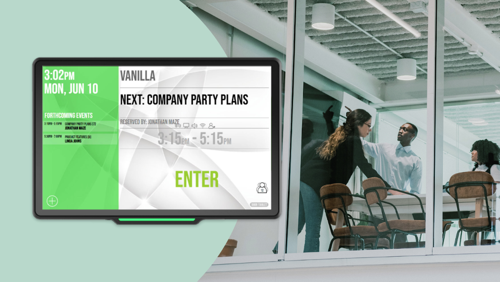
Meeting room booking is one of the most common sources of friction in the workplace. In offices without a clear system, employees often end up chasing receptionists, relying on word-of-mouth, or physically checking rooms just to find a space that might be free.
This leads to awkward interruptions, people walking in on meetings that were already underway, or others sitting outside rooms, unsure whether their team secured the space. When the only booking method is an unreliable shared calendar or a manual process, the entire experience becomes frustrating, inefficient, and prone to errors.
This article breaks down the ideal workflow for booking a meeting room, one that works, without the awkwardness. From finding a free conference room to checking in and wrapping up, it shows how Door Tablet makes every step clearer and faster.
Step 1: Spot What’s Free (Without Playing Detective)
In a cluttered office or unfamiliar floor, knowing what rooms are free shouldn't be a guessing game. Door Tablet makes it obvious. With colour-coded displays (green for free, red for booked), you don’t have to interrupt meetings or ping a Slack channel to ask. You just look and know.
And if you’re at your desk? Door Tablet still makes it easy. The platform integrates with your calendar tools like Microsoft 365, Google Workspace, Exchange, IBM Domino, and Zoom, so you can filter for availability without toggling tabs or guessing who's where.
Step 2: Lock It In
Once you've found your room, you want to act quickly. Door Tablet simplifies booking, so you’re not emailing office managers or waiting for confirmation. Tap the screen, pick a time, and it’s booked.
From your laptop? No extra steps. Just add the room to your meeting invite, Door Tablet’s deep integration ensures your booking shows up on the tablet immediately. The tech stays out of the way, and your meeting stays on track.
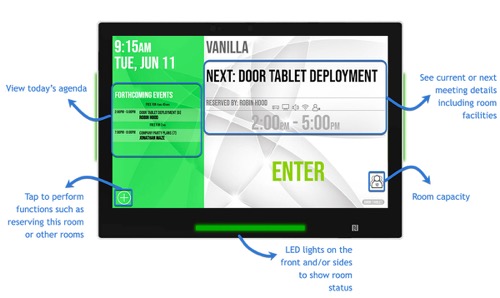
Step 3: Get Confirmation and Meeting Details
After you book, the Door Tablet display updates instantly. It shows your meeting title, organiser, duration, and even the room amenities.
Need a space with video conferencing or a whiteboard? The display can list those, too. It's clarity in action: the right info, at the right time, in the right place.
Step 4: Check In and Avoid No-Shows
You have the option to enable check-ins using a quick tap or RFID badge, something we recommend to prevent ghost meetings. If it's turned on and no one checks in, the room is automatically released. This ensures booked spaces are being used and not just taking up space on the calendar.
“When Our employees are happier knowing they don't have to waste valuable time looking for a space, because with Door Tablet, we always know which rooms are available for use." - Rob Bebout - STI-Tec
Step 5: Extend or End the Meeting as Needed
Need more time? Tap the screen to extend. If no one else has booked the next slot, it’s yours. Wrapping up early? End the meeting, and the room goes back into circulation.
Real Benefits for IT and Workplace Experience Teams
Instead of relying on hallway gossip or complaint emails, they get data: which rooms are being used, when they’re busiest, which ones are always booked but rarely checked into. Patterns start to emerge. You see where space is being wasted, where policies aren’t being followed, and where small tweaks could have a big impact. And because everything updates in real time, there’s no lag between what’s happening in the office and what the system shows.
It helps IT and facility teams:
- Reduce help desk tickets related to room bookings
- Track room usage with built-in analytics
- Configure alerts, themes, and booking rules remotely
It also gives workplace experience teams the insights they need to optimise space, reduce friction, and prove ROI on real estate.
Learn the System, Fast: Door Tablet School
Implementing Door Tablet is surprisingly easy, especially with
Door Tablet School. It’s our free online training space packed with how-to videos, setup guides, and troubleshooting tips. Create an account, and you will be able to access all the videos.
Whether you're setting it up on-prem or in the cloud, the School walks you through every step. Your IT team gets up to speed fast.
A System People Use
If your meeting room booking system causes more stress than support, it’s time to upgrade.
Door Tablet turns clunky processes into straightforward workflows. It helps people find and use conference rooms without friction. And it gives IT and workplace experience teams the tools they need to manage space like pros.
Want to chat about your office and meeting rooms? We are
here
The Best Meeting Room Layouts for Hybrid Teams
On: August 26, 2025

Picture this: it’s 9:02 a.m. on hybrid-day and half your team is jockeying for seats around a table built for twelve while the other half blinks at you from a single laptop perched at the far end. Nobody can see the slides, voices overlap, and the first five minutes vanish into “Can you hear me now?” Sound familiar?
Gensler’s survey finds employees rate “spaces that match the task at hand” as the biggest drawback to the office, beating out snacks, socials, and even flexible hours.
Keep this in mind: bad layout = bad experience. Nail the fit between room size, furniture, and meeting purpose, and you cut start-up friction, boost engagement, and squeeze more value from every square foot of real estate.
This article breaks down four proven layouts: boardroom, U-shape, classroom, and hybrid-ready, plus
space-saving hacks and
meeting room tech essentials, so your meetings start on time and end with results, not headaches.
1. Boardroom Style (Conference Table Layout)
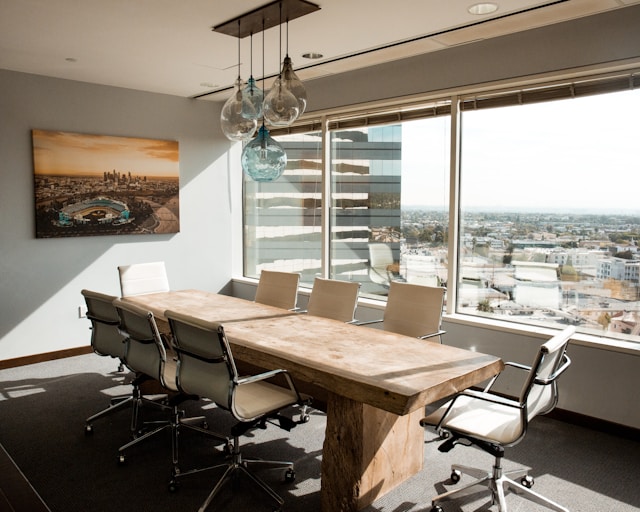
What it is:
The classic boardroom layout features a single large table (often rectangular or oval) with chairs all around it. Everyone faces the centre, which encourages direct eye contact and discussion. It’s essentially an “all heads together” setup.
Best Use Cases:
Leadership huddles, client negotiations, project retrospectives.
Benefits & Tips to Optimise the Space:
- Equal voice, equal view. A single table keeps hierarchy low and body language visible. Optimise: choose a table that matches your average meeting size (4‑8 seats), not your maximum, so it always feels full and focused.
- Rapid decision‑making. Proximity speeds consensus. Optimise: add a wall-mounted display at one short end; now you can flip between face-to-face debate and a quick screen share without neck craning.
- Great acoustics by default. A smaller footprint means less echo. Optimise: add a tabletop mic or ceiling array so far‑end voices carry clearly in hybrid calls.
- The ideal meeting size. Research by Stanford professor Robert Sutton shows the most productive meetings include just five to eight people. Any more, and engagement starts to dip. That’s why a boardroom built for smaller groups,not 20-seat marathons,hits the sweet spot for real decision-making.
- Visual equity with dual screens. A second, mid‑table monitor keeps shared content within everyone’s sightline. Optimise: mount it on a swivel arm so it tucks away during pure discussion.
- Simple cues for time‑boxing. A discreet LED timer on the table keeps agendas tight. Optimise: pre-set 25-minute sprints to sustain focus and clear the room faster.
Watch out for: Boardroom layouts are not ideal for presentations to large groups. If one person needs to present or use a screen extensively, having people on all sides of the table can force some attendees to twist around to see a screen or speaker. It can also become cramped beyond a certain group size, more than 12–15 people, and you’ll have a hard time making eye contact or hearing softer voices at the far end.
2. U‑Shape (Horseshoe) Layout
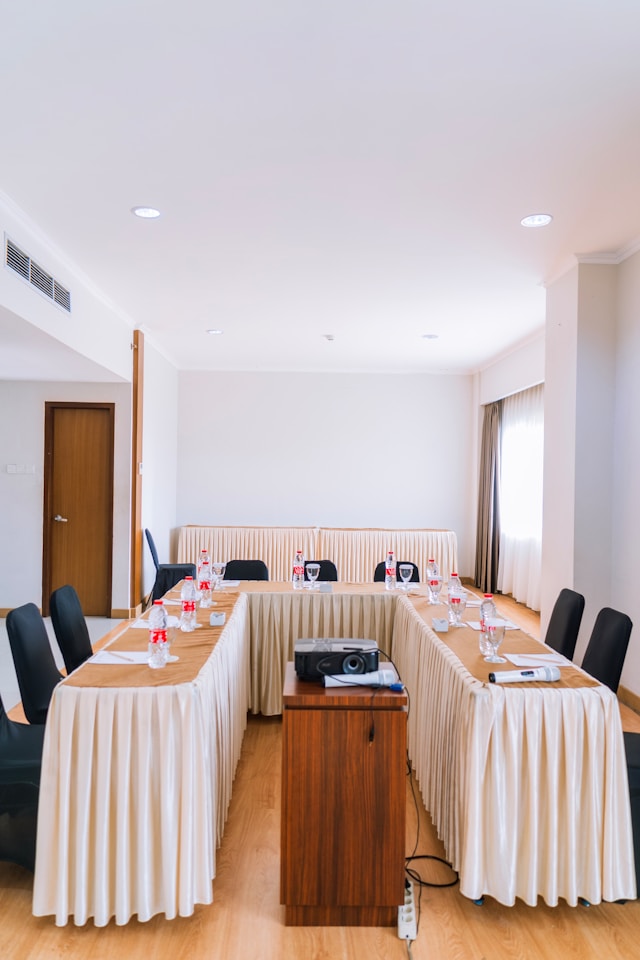
What It Is:
This one is self-explanatory, isn’t it? Tables form a “U”; everyone faces inward with an open end for a facilitator or screen.
Best Use Cases:
Training sessions, design sprints, and hybrid meetings.
Benefits & Tips to Optimise the Space:
- Built‑in presenter zone. The open end spotlights the speaker while attendees keep eye contact with peers. Optimise: park your camera inside the U so remote teammates appear at eye level at the focal point.
- Hybrid‑ready sight‑lines. Participants naturally face the screen. Optimise: mount two small displays: one for slides, one for remote faces, so nobody gets relegated to a thumbnail.
- Space to work. Tables let people use laptops comfortably. Optimise: use modular, folding tables; shrink to a semicircle in tighter rooms.
- Interactive energy. Ideal for workshops: facilitators can step into the centre to shorten the distance and boost engagement.
- Shared sightline for physical collateral. A mobile flip chart at the open end stays visible to all. Optimise: wheel it aside when you switch to group breakout mode.
- Cable‑free tables. Cable‑free tables. Route power through floor boxes under the arms. Optimise: install under‑table USB‑C hubs so chargers stay off the surface, and embed a low‑profile speaker‑mic bar so remote teammates sound like they’re right there.
Watch out for: U-shape layouts are
space-intensive. A U-shaped layout needs a larger room for table space and movement. In small spaces, it may create distance between participants, leading to unequal sightlines. While it sacrifices some seating, it can enhance interactivity. Setting it up takes more time, making it better for planned workshops than quick meetings.
3. Classroom (Lecture-Style) Layout
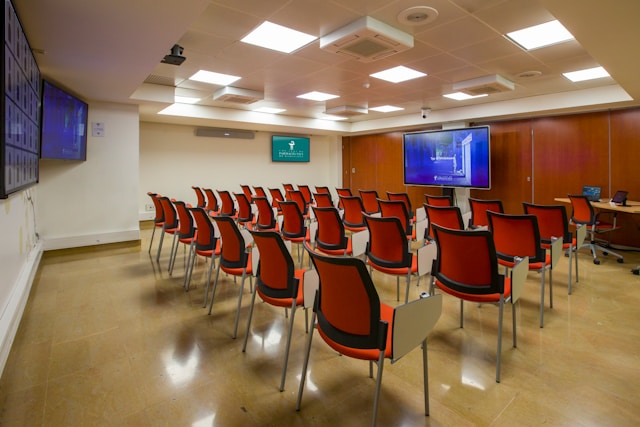
What it is:
A classroom layout mimics a traditional classroom or lecture hall: rows of chairs (and possibly tables) all facing the front of the room. In corporate meeting terms, this could mean multiple long tables with chairs behind them, or simply rows of chairs without tables, all directed toward a presenter’s area or screen at the front.
Best Use Cases:
Town halls, lunch‑and‑learns, and onboarding classes.
Benefits & Tips to Optimise the Space:
- Max headcount in small rooms. Rows fit ~30 % more people than a boardroom of the same size. Optimise: stagger seats theatre‑style so every head sees the screen.
- Presenter control. Focus stays on the front, great for broadcast messages. Optimise: break every 20 min for Q&A; research shows attention dips after the 10‑minute mark
- Easy conversion. Chairs stack; tables wheel away. Optimise: use lightweight furniture so the room flips to a boardroom or U‑shape in < 5 minutes.
- Accessible aisles. Keep a 1 m corridor for safe, easy movement. Optimise: designate a side aisle for the presenter to reach back‑row participants.
- Engagement tech at every seat. Attendees can scan a QR code to join live polls. Optimise: choose meeting apps with built‑in reactions or quizzes to keep energy high.
Watch out for: The obvious downside is limited interaction. By design, classroom layouts are not conducive to discussion among participants. Attendees are facing forward, not facing each other. This can make sessions feel impersonal or disengaging if overused. In a small room, cramming rows of chairs can make the space feel tight and impact comfort. Another drawback in a hybrid context: purely in-person oriented, so if remote participants are present, they may feel like flies on the wall unless you deliberately engage them.
4. Hybrid‑Friendly Layout Principles
(Think of these as a layer you overlay on any room.)
Principles & Optimisation
- Every face on camera. Arrange seats in a semi‑circle or on the table edge that faces the screen. Optimise: dedicate a second display solely to remote attendees so they keep presence when slides go up.
- Crystal‑clear audio. Good sound beats good video in perceived quality. Optimise: install a single all‑in‑one soundbar for small rooms; add ceiling mics in larger spaces.
- Equal content access. Digital whiteboards let everyone co‑create. Optimise: if you stick with analogue, point a camera at the board or transcribe in real time.
- Camera at eye level, not ceiling. Mount primary cameras at ~1.3 m for natural conversation. Optimise: pick auto‑framing models that zoom on whoever’s speaking.
- Ambient lighting. Soft, indirect LEDs around the monitor cut glare and flatter faces. Optimise: connect lights to occupancy sensors so they dim when the room is empty.
Layout examples:
- The “semi-circle” approach: Arrange chairs in a semi-circle (or around a half-table) facing a wall-mounted screen/camera. This is great for small team scrums with a few remote teammates.
- The “distributed pods” approach: In a larger room, you might have small clusters of tables (pods) for breakout discussions, each with its camera or a portable camera you move around when that group speaks. This is advanced, but some teams do it to mimic putting a remote person “at the table” with each group.
Key Insight: 63% of companies are actively modifying their office layouts to better support hybrid work models. (CBRE)
Making the Most of Small Meeting Rooms (Optimising Downsized Office Spaces)
When space is tight, every room has to work a little harder. And that’s not hypothetical; 75% of businesses plan to shrink their office footprint. Whether it’s a strategic real estate move or a post-hybrid rethink, small rooms are officially doing the heavy lifting. So how do you make the most of them?
- Choose flexible, modular furniture. In a small room, flexibility wins. Lightweight, movable tables and nesting chairs let you switch from boardroom to brainstorming fast. Mobile whiteboards and foldable surfaces make it easy to reset the space.
- Embrace the “huddle room” concept. Smaller rooms (2–6 seats) are better matched to how most teams meet today. Think quick check-ins, video calls, or 1:1s. Gensler found more companies are prioritising compact, tech-ready spaces over oversized boardrooms that sit empty.
- Optimise for privacy and focus. Small enclosed rooms are in high demand, especially post-hybrid. People want spaces where they can concentrate or have a private call. Add acoustic panels or white noise to buffer sound.
- Clever storage and minimal clutter. In tight spaces, clutter quickly becomes a barrier. Mount shelves to the wall, use slim under-desk drawers, and choose stackable chairs. Avoid bulky cabinets. Clear floors = clear minds and more flexibility to move things around.
- Leverage walls and vertical space. Save floor space by wall-mounting your screen. Turn an entire wall into a collaboration zone with whiteboard paint. Add bright, indirect lighting to open the room visually.
- Booking and utilisation hacks. Use meeting room booking and auto-release rules to avoid ghost meetings. Default to 25-minute sessions for better room churn.
- Creative multipurpose areas. If you’re short on rooms, rework shared spaces. Add curtains or partitions to carve out semi-private nooks. Use your café or lounge as a backup meeting space with temporary seating.
Smart Meeting Rooms ❤️ Smart WorkspaceTech
No matter the layout, the right technology is the backbone of a modern meeting room. Especially in hybrid workflows, tech tools ensure scheduling is smooth, everyone knows what’s happening, and remote collaboration is seamless.
Room scheduling displays
Wall-mounted displays outside rooms take the guesswork out of booking. They show real-time availability, upcoming meetings, and let people book on the spot. With clear green/red status lights visible from down the hall, employees don’t have to knock or squat in “maybe-free” rooms. The room booking displays from Door Tablet also feed usage data to workplace experience teams, so you can see what’s overbooked and what’s underused.
Tip: If you’ve downsized or flexed your office footprint, these displays are invaluable for keeping rooms moving. Door tablet’s booking software syncs with your calendar system.
Video conferencing equipment
Every meeting room needs solid video gear. At minimum: a screen, camera, and mic/speaker combo that’s easy to use. Small rooms might just need a plug-and-play soundbar with a built-in camera. Bigger rooms? Go for multiple mics and a dedicated device that supports one-touch join. Always place the camera at eye level and centre it so remote teammates see faces, not walls.
And please, test it regularly. You don’t want to call IT in the middle of a client meeting, do you?
Interactive displays and whiteboards
Digital whiteboards help bridge in-room and remote collaboration. People can write, sketch, and share ideas in real time. Some even let remote users contribute. If that’s not in the budget, pair a regular whiteboard with a camera facing it. That way, nothing important is lost to the people on the call.
Bonus: Many interactive displays also work as standard screens, so you get more bang for your space.
Wireless screen sharing
Loose cables are meeting momentum killers. Wireless screen-sharing tools let people cast from their devices quickly without the awkward cable-passing.
Digital signage and integrations
Screens near entryways that show what’s booked and what’s available across the office reduce confusion. Think of it like airport departure boards, but for meeting rooms. Some systems also use lights above doors (green = open, red = busy) to give quick visual cues from a distance. This kind of visibility helps reduce accidental interruptions and gives staff a clearer sense of space availability, especially in fast-paced or shared environments.
Motion and environmental sensors
These sensors aren’t flashy, they should be invisible. Motion sensors can free up rooms when no one is there, while CO2 or temperature sensors help keep the environment comfortable. A spike in CO2 might signal stuffy air, automatically nudging HVAC or reminding someone to crack a window. You don’t need this in every room, but adding it to key spaces can boost comfort, save energy, and give facility teams useful data on how spaces are really used.
Conclusion: Tailor the Space to the Work
Designing the best meeting room layout really comes down to understanding your team’s work patterns and goals.
You might mix and match the layouts we mentioned across your office. A small company could have one formal boardroom, a couple of huddle rooms with U-shape or flexible furniture, and a larger common area that can switch to classroom style on demand. The key is flexibility.
As one Gartner finding suggests, hybrid teams succeed by adapting meeting formats to fit the outcome. Your spaces should empower them to do exactly that, easily shifting from brainstorming in the round to presentation mode and back again.
A well-laid-out meeting room might not guarantee the meeting itself is amazing, that still depends on us humans to have good agendas and communication, but it removes the barriers and irritations that often derail meetings.
Meeting Room Etiquette for Modern Offices
On: August 18, 2025

Unwritten Rules, Unhappy Rooms
Every workplace shares the same silent code: respect the space and the people you share it with. We like to think everyone follows it instinctively, yet lunches still disappear from the shared fridge and personal calls occasionally play out on speaker across the open floor. The same happens when we step into meeting rooms. Bookings linger long after plans change, rooms sit empty but marked “busy,” and teams bump into one another like commuters at rush hour.
The fallout is larger than an inconvenience. Meetings start late, projects stall, and frustration spreads. Multiply the wasted minutes by headcount, and etiquette lapses become a productivity drain, not to mention a hit to trust in workplace tech. The math doesn’t look good.
Did you know that poor meeting room management can cost companies up to
$37 billion annually in wasted time and resources?
(HBR)
Good manners still matter, but hybrid schedules and shared resources demand clearer guardrails. This guide outlines how IT and Workplace teams can set those guardrails, using policy, nudges, and automation, so shared rooms stay fair and functional for all.
Why Meeting Room Etiquette Matters (A lot)
There’s nothing more frustrating than planning a meeting, showing up early, and finding your room mysteriously taken or worse, booked but empty.
Gartner reports that ghost meetings account for
up to 20% of bookings, skewing utilisation metrics and stretching facilities budgets.
A single act of poor etiquette can topple the whole booking ecosystem. When someone squats in a room without reserving, or leaves a ghost meeting occupying the calendar, they signal that the rules are optional. Colleagues notice and start bypassing the system too:
“Why bother cancelling? No one else does.”
Before long, the schedule is full of fiction, and employees roam hallways in search of real‑time space.
In short, broken etiquette erodes the social contract that keeps shared resources working. The good news is, there’s a way out of this chaos.
Implementing Etiquette: Practical Steps & Smart Solutions
Etiquette improvements work best when they blend
people practices (nudges and policies) with
technology assists. Here are some battle-tested tactics that IT and Workplace teams can deploy to tame the meeting room madness:
-
Introduce Mandatory Check-Ins & Auto-Release
One of the simplest and most effective etiquette enforcements is requiring people to confirm their meeting when it starts. For instance, have a check-in button on the room’s tablet display or a prompt in the booking app. If nobody checks in within, say, 5–10 minutes of the meeting’s start, the system automatically frees up the room for others.
This single step attacks the ghost meeting problem head-on; thus, no-show bookings won’t linger and block space. Modern room booking systems like Door Tablet can also integrate occupancy sensors to do this hands-free: if the room stays empty, it auto-releases.
It’s a friendly way of saying “use it or lose it” that benefits everyone. Just be sure to communicate this new process clearly so attendees aren’t caught off guard by cancelled meetings. Once a habit, people will appreciate that empty rooms become available again instead of sitting wasted.
-
Set a Cancellation Window (Buffer Time)
Life happens, meetings get cancelled last minute or shifted to Zoom, but we need a way to give those rooms back to the people. Establish a policy (and system setting) for cancellation cutoff times. For example, require cancellations at least 15 minutes before the start or as soon as the organiser knows the meeting won’t happen. This creates a buffer that opens the slot to others who might need a room right now.
Pair this with gentle reminders: a nudge email or notification an hour before, saying, “Still using Room A at 3 pm? If not, please release it for others.”
The key is to make cancellation easy (one-click in the software) and culturally accepted; no one should feel bad for cancelling; they should feel helpful for freeing space.
-
Use Digital Signage for Transparency
Ever walked up to a meeting room not knowing if it’s free until you peek inside? Good etiquette goes hand-in-hand with good visibility. Consider installing meeting room displays or digital signage that shows the room’s schedule in real time right by the door. Even a standard tablet or an e-paper sign synced with the calendar can go a long way.
This way, employees can self-serve: a glance tells you if the room is in use, who has it next, or if it’s free (and for how long). No more awkward door knocking or accidental walk-ins. Signage can also gently reinforce etiquette, e.g. a message on the screen that says “Remember to check in to confirm your meeting” or colour codes that turn a room red if someone is over their booked time.
When people see the system working and the expectations clearly, they’re more likely to follow suit. Plus, it helps workplace experience teams monitor usage at a glance during walkthroughs.
-
Standardise Your Booking Workflow
Consistency is queen when it comes to etiquette. Pick a single source of truth for room reservations (whether it’s Outlook, Google Calendar, or a dedicated booking platform) and integrate everything with it. Many organisations are embracing integrated workplace platforms that sync with Outlook/Google, so double-bookings can’t happen. If the conference room is taken, it’s taken.
If you haven’t already, connect any room tablets or booking panels to that same system to avoid conflicts. Then, document the workflow: e.g. “All meetings must be booked via the company calendar; ad-hoc walk-in use is allowed only if the room shows available and you use the panel to book it on the spot.”
By training employees on one consistent process, you eliminate the wild variances. Make it part of onboarding for new hires and refresh everyone periodically. The goal is that everyone knows how to book a conference room, how to cancel, and what the norms are. When the workflow is uniform, it’s much easier to spot where things break down, and it avoids putting the burden on individuals to be “room police.”
-
Establish Friendly Policies (and Consequences)
Alongside tech fixes, lay out a few ground rules in a positive, blame-free tone. For example, set a reasonable maximum booking length (maybe 2 hours) to prevent marathon bookings that hog space. Encourage buffers between meetings (e.g. end meetings 5 minutes early) so there’s transition time; this can be configured in some calendar systems, too.
You might also implement no-show penalties as a last resort: for instance, if someone repeatedly no-shows (e.g. 3+ times/month), restrict their ability to book premium or high-demand rooms for a short time.
In practice, just knowing there’s accountability often curbs the behaviour, so you never have to enforce the penalty. Another important policy: regularly audit recurring meetings. Those weekly team syncs that got cancelled indefinitely but are still on the calendar are prime ghost meeting fodder.
Every month or quarter, have the system or an admin send a list of recurring bookings to organisers, asking, “Are these still needed?” If not confirmed, clear them out. Overall, frame these policies as etiquette guidelines that help everyone, not as strict edicts.
It’s not about control, it’s about respect.
When employees see these rules as ways to respect each other’s time and the shared space, compliance naturally improves.
-
Ensure Visitor-Ready Meetings
For Workplace Experience teams, especially, meeting room etiquette extends to how we host clients or guests. Nothing is more embarrassing than a VIP visitor arriving for a meeting only to find no room available or a technical glitch delaying the start.
Incorporate visitor readiness into your etiquette playbook. This might include reserving a lobby or prep room for guest waiting areas, making sure meetings with external visitors aren’t booked back-to-back with no setup time, and checking that AV equipment is functioning beforehand.
Plus, it spares IT the frantic last-minute requests like “the client is here and the projector isn’t working!” by baking preparation into the process.
If you use a visitor management system, tie it into your room bookings - e.g. when you book a room for an external meeting, flag it so reception knows to expect guests and the room is presentable.
If people understand
why these etiquette rules exist and how they benefit everyone, they’re far more likely to get on board. So communicate the “why” behind each change. For instance, share that
“our occupancy data showed 25% of booked rooms were going unused. We’re introducing auto-release on no-shows to make more space available and reduce frustration.”
When employees see the company investing in tools and norms that make their day easier, they’ll reciprocate by following the guidelines.
Building a Human-First Meeting Culture
At the end of the day, meeting room etiquette isn’t just a set of rules or a piece of software; it’s a culture shift. It’s about moving from “Every team for itself” to “We’re all stewards of our shared space.” When IT and Workplace teams champion this approach, backed by leadership support, the office transforms from a source of stress (“Why is nothing working?!”) into a facilitator of productivity and collaboration.
You’ll rebuild confidence that the office is a place where things just work. In an era when workers have plenty of reasons to stay home, that reliability and ease can be a game-changer. As one
Gartner report noted, a well-run, tech-enabled workplace isn’t a luxury; it’s expected by today’s employees. The effort you put into meeting room etiquette now will pay dividends in a smoother operation, happier teams, and a workplace that truly feels worth coming into.
So go ahead – be the
ghostbuster of those empty meeting rooms and the champion of a new etiquette. Your colleagues (and your future self stuck in a hallway on a call) will thank you for it. After all, a little bit of courtesy, combined with the right tools, makes the office a place where everyone can meet, collaborate, and thrive without the drama. Good luck, and happy booking!
The ROI of Meeting Room Booking Tech
On: August 5, 2025

If you’re in charge of the workplace experience, you probably hear this more than anything: "We need to justify the spend." Whether it's a tool, a redesign, or something as seemingly small as a meeting room tablet, ROI is the first and last question in the room.
Now, let’s talk about meeting rooms. You already know they’re one of the most frustrating parts of office life. Double-bookings. No-shows. Wandering the halls trying to find a free room. And when you're the one expected to fix it—or worse, justify why it's worth fixing—it can feel like you're solving a problem no one sees until it’s a crisis.
Here’s the reality: meeting rooms are expensive real estate, and the way most companies use them is wildly inefficient. According to a
CBRE workplace report, average meeting room utilisation hovers around just 30–40% in most offices.
And it’s not just about empty space—it’s about wasted time. According to
the Harvard Business Review, unnecessary or poorly managed meetings cost companies $37 billion (that’s right! Billions with a B) in lost productivity annually, often due to inefficient scheduling and underutilised meeting spaces.
Further supporting this, research published in the
Journal of Organizational Behavior found that meeting quality significantly impacts perceived work time waste, with poorly scheduled or unnecessary meetings leading to disengagement and reduced efficiency.
If you factor in the ripple effects of ghost meetings, blocked rooms, and last-minute rescheduling, it's easy to see how teams lose valuable time each week. For a team of 100, even modest delays or room-finding struggles can quickly add up to hundreds of lost hours monthly, time that could be better spent doing meaningful work.
If you want to see the REAL cost of ghost meetings, we covered this in a
previous article.
What Stakeholders Want to Know
So, how do you make the case for better meeting room tech, especially when budgets are tight and every expense is under the microscope?
Here’s what leadership wants to hear:
- What are we losing by not fixing this?
- How much will this save us in time, space, or costs?
- Can it integrate with what we already use?
When talking to stakeholders, focus on what matters to them:
- Quantifiable savings: How much money the business loses on underutilised rooms, delays, and ghost meetings.
- Time efficiency: How many hours employees could get back with better meeting room booking tools
- Integration readiness: Whether the solution plays well with existing systems like Microsoft 365 or Google Workspace.
- Data-backed space planning: The ability to use room analytics to make smarter, cost-saving decisions.
- Employee experience: Every delay or double-booking chips away at morale and productivity.
You’re not pitching tech—you’re presenting a fix for wasted space, wasted time, and unnecessary cost.
Let’s talk about Solutions
This is the part where we will tell you how Door Tablet is more than a digital sign on a wall, it’s a full meeting room management system that solves the meeting room booking pain points everyone deals with.
Key Features That Matter:
- Room Availability at a Glance – Meeting room tablets light up green when a room is free, red when in use. No more peeking through glass walls or interrupting meetings.
- Tap-to-Book – Book a room directly from the tablet or from your existing calendar platform (Google, Microsoft 365, etc.)
- Auto-Cancellation for No-Shows – If no one checks into a meeting within a set window, the system frees the room. Ghost meetings? Gone.
- Real-Time Syncing – All bookings update in real-time across devices and calendars, eliminating double-bookings and guesswork.
- Analytics and Insights – See which rooms are used, when, and how often. Optimise space or reconfigure underutilised areas based on actual data.
- Wayfinding Displays – Get a clear view of what’s happening across the office and book any available room right from the lobby, no need to wander the halls.
- Nearby Room Booking – Use each display to find and reserve nearby available rooms instantly.
- Motion Sensors – Enable smart automation and enhance privacy by detecting actual occupancy, reducing booking conflicts and unnecessary interruptions.
How to calculate the ROI
If you're preparing to pitch a meeting room solution to leadership, it's worth framing your case in numbers. Here's a simple framework you can use to calculate the ROI, and tie it directly to what Door Tablet helps unlock.
Step 1: Start with space costs
- Estimate the cost per square foot of office space (e.g. £100/sq ft in central London).
- Multiply by the average size of your meeting rooms (e.g. 300 sq ft).
- Calculate the annual cost per room.
- Estimate underutilisation percentage (e.g. 30% unused = £9,000–£13,500 wasted per room/year).
Step 2: Factor in time lost
- Estimate the hours employees spend per week dealing with scheduling issues, delays, or room hunting (e.g. 2 hours/week × 100 people = 10,000 hours/year).
- Multiply by your average hourly salary rate (e.g. £30/hour = £300,000/year lost).
Step 3: Project potential gains from meeting room tech
- Auto-released rooms: If a 300 sq ft room costs £30,000/year, recovering even 20% of its unused capacity could project a gain of £6,000 per room annually.
- Time saved: Saving 1 hour/week per employee (valued at £30/hour) projects to £1,560/year per person. For 100 employees, that’s £156,000/year in potential productivity.
Use this structure to show what’s at stake and how meeting room tech directly drives business value.
Final Thoughts
If you’re part of a workplace experience, real estate, or IT team trying to advocate for better meeting room tools, talk about the lost hours, not just the shiny screens. A meeting room booking system like
Door Tablet doesn’t just help meetings run on time—it helps the business run more efficiently.
Want to see it in action? Visit
door-tablet.com or get in touch for a
demo.
Smart Office Layouts That Work for Every Employee Style
On: July 24, 2025

Not every employee thinks, works, or even focuses the same way, and your office space shouldn’t assume they do. If we’ve learned anything from the past few years, it’s this: a smart office layout needs to do more than just look sleek. It needs to work for everyone.
Let’s dive into a trend that appeared in recent months. If you’re not familiar with it, we’ll explain exactly what it is. People are showing up, swiping their badge, grabbing a coffee, and heading right back out. That’s
coffee badging, and it’s becoming the go-to move for employees trying to meet return-to-office mandates without actually spending the day in the office.
It’s not laziness. It’s a protest. A quiet, practical protest against the kind of office experience that leaves people feeling like they’re wasting time. When you’re commuting just to take Zoom calls in a noisy room or getting derailed by a dozen well-meaning interruptions, it’s hard not to wonder: what’s the point of being here?
Just
26% of workers strongly agree that their current workplace helps them do their best work, indicating that while presence has returned, performance has not.
(Gensler’s 2025 Global Workplace Survey)
At home, people feel more in control. They can focus, take breaks on their own terms, and structure the day around getting real work done, not finding a room, dodging distractions, or pretending to be productive in a space that wasn’t designed with their needs in mind.
This isn’t about being anti-office.
It’s about wanting the commute to feel worth it. That’s why the conversation is shifting from how much space we have to what kind of experience we’re creating with it. The best offices aren’t full of stuff; they’re full of purpose.
That’s the heart of space quality. And where design begins to merge with workplace strategy.
The Case for Mixed-Use Layouts
Static layouts belong in the past. Teams are more diverse than ever in how they approach the workday: focused analysts, collaborative designers, part-time office visitors, full-time desk regulars. A smart office layout recognises this diversity and plans for it.
Research backs this up. According to
CBRE, companies that use activity-based layouts—zones designed for specific tasks, such as deep work or collaboration—experience higher productivity and satisfaction levels. Instead of overcrowding the area, you tailor the space to fit its intended purpose.
“For too long now, our workplaces have been static instead of dynamic. We sit at one desk all day long with occasional meetings to break up the monotony. But we know that our workdays aren’t static. We’re constantly doing different tasks that require different environments.”
Designing for Real People, Not Just Roles
Real impact comes when you stop designing for job titles and start designing for behaviours. For this article, we’re exploring five common work styles and the spaces that help them thrive. Let’s dive in:
The Focused Worker
Whether they’re deep in code or crafting detailed reports, these employees need uninterrupted time. A
study published in the journal ‘Environment and Behavior’ found that employees in open-plan offices experienced a
66% decrease in their ability to focus on deep work tasks compared to those in private offices.
What they need: Think quiet rooms, library zones, or soundproof pods. Simple, uncluttered design. Adjustable task lighting. Minimal distractions. Focused Workers crave
*control * over noise, lighting, and interruptions. The more autonomy they have in shaping their environment, the more productive they’ll be.
The Collaborator
They’re the energy in the room—your creative leads, product squads, and team-first thinkers who work best when ideas are flowing out loud. Collaboration isn’t a meeting to them—it’s a rhythm. And space shapes that rhythm.
According to
Gensler’s 2023 Global Workplace Survey, employees are
2.5× more likely to say their workplace supports both individual and team productivity when they have
access to diverse, task-based spaces, especially ones built for collaboration.
What they need: Open project tables, movable seating, writable walls, and reliable AV setups that support both in-person and hybrid teams. These workers move fast, think visually, and pivot often, so their space should too. They thrive in zones that let them sketch, stand, shift, and spark off each other without booking a boardroom every time.
Let us give you a visual: remember the creative bullpen in
Mad Men where Peggy and her team worked? That space had colour, energy, and all the supplies they needed—and while it wasn’t completely closed off, it had just enough separation to let ideas breathe without constant interruption. That’s what momentum looks like in physical form.

“Great Spaces that provide access to private areas, flexible environments, and the ability to control lighting and noise levels are leading the way.”
The Connector
They bridge teams and fuel your culture. According to
Gallup, employees with strong social ties are more likely to be engaged and stay long-term, but only
25% feel they have enough informal space for connection.
 What they need:
What they need: Open lounges with soft seating, tall tables, and spots that naturally invite conversation. These areas work best when placed along high-traffic paths—near kitchens or meeting rooms—so casual bump-ins feel effortless. Lighting should be warm, and a bit of greenery or texture makes it more inviting. Think café vibe, not corridor. Connectors thrive in spaces that feel social by design. They want to be seen, to connect, and to help others do the same.
The Floater
They’re the drop-ins: sales reps, consultants, or hybrid staff moving between home, office, and client sites.
CBRE found that
87% of workers now expect to choose their work setting based on task, and Floaters embody that mindset.
What they need: Easy access to a spot to work, no fuss. Touchdown spaces near entrances.
Bookable desks. Charging ports and good Wi-Fi. They value
efficiency. Make it easy for them to land, plug in, and get going. Think desks equipped with a monitor, keyboard, mouse pad, desk supplies, and headphones. Don’t forget to add a touch of greenery to the desks.
The Quiet Achiever
They’re steady, thoughtful, and often overlooked. These are the introverts and behind-the-scenes stars.
Gensler notes that individual work satisfaction is highest in environments that provide choice and privacy.
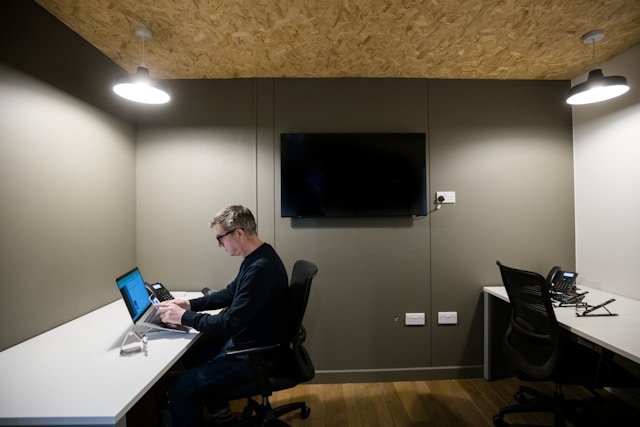 What they need:
What they need: Low-traffic spaces with soft acoustics and visual privacy, like quiet corners with high-backed seating, small two-person meeting rooms, or semi-enclosed nooks. Materials should be soft and warm: think felt, fabric, wood accents. Lighting should be adjustable and indirect. These are the people who thrive in calm, focused environments where they can choose when and how to engage. Quiet Achievers value
psychological safety, so their ideal space offers calm by default, not through isolation but through comfort and control.
Flexibility Is the New Fixed Asset
Your office shouldn’t freeze in place. When it’s designed for change, it can flex with your team’s needs. When you design for how people work, you get an office people want to return to.
It’s not about pleasing everyone. Some will always prefer remote or hybrid, and that’s okay. What matters is that the office supports the kind of work people can’t easily do at home. When it does, they’ll keep coming back because it helps, not hinders.
That’s the kind of office that earns its place in the future of work.
The place for Workplace Management Technology in a Smart Office
Door Tablet helps keep the office flowing, literally. Its real-time room and desk displays, one-tap booking, and meeting room usage insights help people move through the office without second-guessing where to go or whether a space is free.
It smooths out the booking bottlenecks that kill momentum, especially for teams who rely on spontaneity and quick decision-making. In a smart office, flow matters, and Door Tablet makes that flow effortless.
Curious how Door Tablet could help your team navigate the workplace with less friction and more flexibility? Explore more at
door-tablet.com or
get in touch for a personalised walkthrough.
Bring Teams Back to the Office Without the Pushback
On: July 15, 2025
So the return-to-office mandate is in place. People are coming in. Desks are being claimed. Coffee machines are back in use. But here's the thing HR and workplace experience teams know better than anyone: just because people are in the office doesn’t mean they’re comfortable being there.
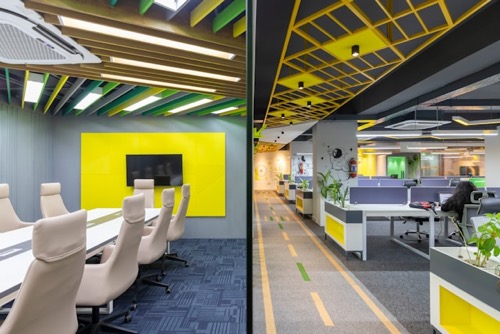
This next chapter is less about enforcing attendance and more about shaping an experience worth showing up for. You’re not just managing a seating chart. You’re managing uncertainty, social energy, friction, and a hundred invisible emotional checklists.
Here’s how to turn those awkward first few weeks into a smooth, even enjoyable, transition.
Start with Autonomy, Not Attendance
Fun fact: Many
Gen Z workers started their careers remotely and have had little to no in-person office experience. Some were in high school or university when the world went virtual. Crazy, right? Gen Z is
actually leading the return-to-office charge, averaging three days a week on-site, according to JLL. They want the best of both worlds: face time
and remote time.
Give people a reason to show up - on their own terms. Because the reality is, no one likes being told where to work. But they will come in if they know their team will be there, if there’s a purpose to the day, or if the space makes the work easier.
- Let teams co-create their schedules. Instead of blanket rules, encourage team-level norms. This gives employees ownership and clarity.
- Surface the "who's in" intel. Visibility is everything. The more people know, the easier it is to plan meaningful in-office time.
- Connect the why. Whether it's access to mentorship, better collaboration, or just getting out of the house, tie office days to actual benefits, not obligations.
Flexibility = a retention tool. People are far more likely to leave a company if they feel forced into rigid schedules that don’t fit their lives. In fact,
48% of workers say they would consider quitting if forced into full-time office attendance. That number jumps to 58% for women, compared to 42% for men.
Eliminate the Friction Nobody Talks About
You’ve got them in the building—great. Now don’t lose them to bad systems.
- Fix the basics. Room panels should reflect real-time bookings. Desk reservations shouldn’t be a guessing game. Wi-fi should be working smoothly.
- Invest in wayfinding. Whether it’s your first day or your first time on the third floor, people appreciate knowing where to go.
- Remove friction. There is no need to ask the receptionist to book a room for you. Your people should be able to schedule a room in a few seconds.
CBRE reports that 63% of employees have been unable to find a meeting room despite seeing open ones. That’s not a design issue. It’s a systems fail.
Design for How People Work
Today’s office shouldn’t feel like a throwback to 2019. It should meet people where they are now and how they get work done.
- Variety wins. Quiet zones. Collaboration hubs. Private nooks. Mix it up.
- Keep it flexible. Modular furniture, movable whiteboards, and reservable everything give teams the freedom to adapt.
- Listen to the data. Sensors and booking analytics show what’s working and what’s not. Use it.
Workplace design isn’t about fitting more people into fewer square feet. It’s about building spaces that support energy, focus, and flow.
Prioritise People, Not Policy
Your space can be beautiful, your tech flawless, and your snacks on point, but if you prioritise the return-to-office mandate over your employees' readiness to come back, it all falls flat.
You risk losing the trust and engagement that make a workplace thrive. People want to feel like they matter more than a policy. They want to be seen not just as headcount, but as humans with different rhythms, needs, and boundaries.
So if you’re trying to make the return to office feel a little more human, think about it like this:
- Normalise the nerves. Social anxiety, burnout, and change fatigue—these are real. Create space to talk about it (tap into mental health services)
- Ditch the pressure. Make social events optional, inclusive, and low-key.
- Make the office worth the trip. Highlight what they can’t get at home: face time with leaders, faster decisions, spontaneous chats, or even just a better space to focus.
Your RTO Readiness Checklist
Because the difference between a good return and a painful one is usually the little things.
☑️ Reliable tech (Wi-Fi, video conference tech, room booking systems)
☑️ Clear visibility into who’s in when
☑️ Purpose-driven space variety (quiet, social, private)
☑️ Clean, comfortable, stocked environment
☑️ Clear, consistent communication
☑️ An HR open line for ongoing feedback
Strategy Over Space
A successful return strategy centres on emotion as much as logistics. It’s about helping people reconnect on their own terms, building in flexibility, and showing that their personal work styles and preferences aren’t just tolerated but respected.
Ready to make your RTO strategy work for your people?
Door Tablet helps you simplify bookings, reduce first-day friction, and create a workplace experience worth showing up for.
What a Great Workplace Experience Looks Like in 2025
On: July 8, 2025

Forget trends. Forget mandates. Forget whether people are coming in two days or four.
The real question we should be asking is:
What do employees need from their workplace to feel supported, productive, and excited to do their best work?
Because that’s what great workplace experience is about. Not policy. Not compliance. Experience.
In 2025, employees are showing us what matters: spaces that give them control. Tech that doesn’t fight back. Layouts that reflect how people work, not how space used to be managed.
This article breaks down what employees say they want and what workplace experience teams can do to deliver it. We’re not here to talk about hybrid strategies or how many desks you need. We’re here to talk about people. And how to build places that work for them.
Let’s dig in.
1. Flexibility is non-negotiable
Let’s start with what everyone’s already feeling: rigid offices just don’t work anymore. A
CBRE study found that
52% of employees want a workplace that gives them options—spaces where they can choose how and where they work based on the task at hand.
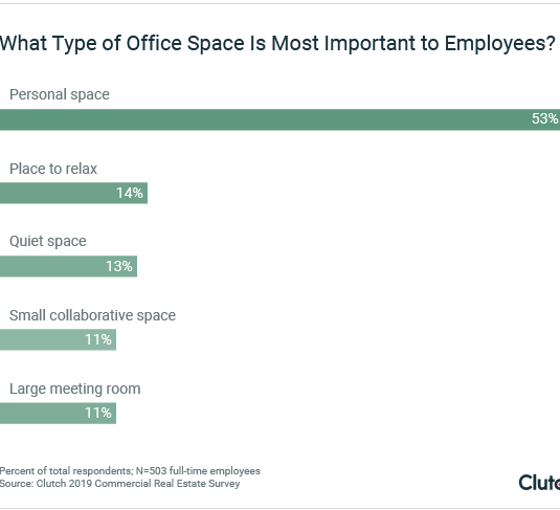
This means more than just throwing a few beanbags in the corner. We’re talking:
- Quiet rooms for deep focus
- Social zones for spontaneous convos
- Collaboration spaces for heads-together work
- Private call pods for, well, privacy
Over
65% of companies are already reducing desk density and shifting to activity-based layouts to reflect this reality. Employees want autonomy. The workplace has to support it.
2. People want their personal space
Yes, hot desking is here to stay. (*but only in specific use cases*, read
this article about the use case of hot desking) But employees haven’t given up on having a space that feels like their own.
53% say their personal workspace is the most important part of the office.
Open plans? They’re not the productivity boosters we hoped for.
Harvard research showed that
face-to-face interaction dropped
70% when offices removed walls. That’s not exactly collaboration.
Still a believer in open office spaces? Check out
this article about the state of the Open Office Layout
The best offices balance open and private. That might mean reservable desks, quiet pods, or just knowing you can count on a space being yours when you need it. Nearly
98% of employees still have an assigned spot, which tells you something about what they value.
“Great workplaces are intentionally designed to evoke feelings in a space by overlaying experience factors with space function. The most important experience factors that promote workplaces from good to great include feeling that the space is beautiful, welcoming, and inspires new thinking.”
3. Amenities are a deal-maker
Office amenities are the little things that transform a regular workplace into an exceptional one. They are thoughtful extras that elevate working conditions beyond contractual job requirements.
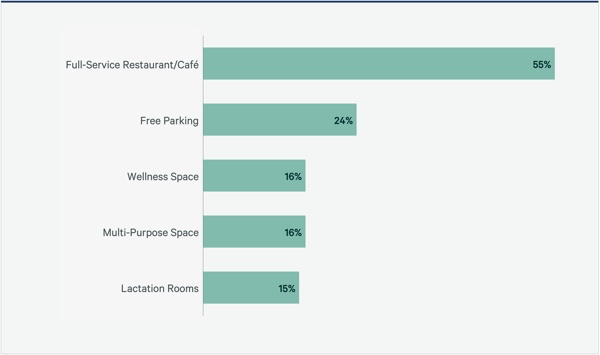
You don’t need to turn your office into a wellness resort. But the basics have to be there. Think:
Natural light and LED lights (no one likes those fluorescent lights in the office)
- Comfortable seating
- Clean air
- Quiet Zones
- Fully stocked kitchens
- Multi-purpose spaces
According to
JLL,
75% of companies now prioritise amenities like on-site gyms, cafés, and green spaces when selecting office space. And for good reason. These perks are signals.
Signals that say: we care about your well-being, not just your output.
And yes,
social spaces matter too.
Gensler found that
80% of employees report that social zones enhance their satisfaction. A good office gives people room to connect. Sometimes the best ideas happen near the coffee machine or in the office lounge.
“The best offices know how to be comfortable and convenient enough where it encourages employees to be in the office during the workday rather than wanting to be at home doing work”
- Max Fal, Fueled
4. Tech that does what it says it does
Employees won’t battle broken booking systems. They won’t fight for a desk, troubleshoot a touchscreen or a print machine. Over
40% of hybrid workers avoid the office because the tech experience is bad, according to
Gartner.
Now that we’ve established their space needs, those spaces need to be linked with the right workplace tech for people to enjoy their time in the office.
Here’s how we’d pair the tech to the spaces employees value most:
- Quiet Zones – Spaces for deep work need minimal distractions and clear boundaries. Think noise-cancellation tech, sound masking systems, and ambient light controls to set the tone for focus. Install red/green status lights outside the zone to signal availability without anyone needing to knock. Pair that with desk-level indicators, devices that let others know when a workstation is taken. Add adjustable lighting and smart air quality monitors to keep comfort levels. Add in soft seating or height-adjustable desks to help employees drop into a state of flow without interruption.
- Collaborative Areas – These zones benefit from large whiteboards, wireless screen-sharing tools and real-time room booking displays from Door Tablet to signal who’s booked the space and for how long.
- Meeting Rooms – For both face-to-face and virtual meetings, tech should be seamless. The meeting prep starts before the actual meeting. It starts with booking a meeting room. We've all had that moment—you thought you booked the room, but it turns out you didn’t. Someone else is already inside, and now you're scrambling five minutes before your meeting. What if the meeting room booking worked every time? Door Tablet’s meeting room displays, integrated with Microsoft 365 and Google Workspace, show real-time room status, support instant booking with a tap, and even auto-release rooms if no one checks in. That means no more double bookings, no calendar syncing issues, and no standing awkwardly outside an occupied room.
- Desks – Whether it’s hot desking or reserved seating, employees want their desk setup to feel smooth and personal. Door Tablet’s desk devices and desk booking software offer a real-time visual of which desks are booked and which are available, so finding a desk doesn’t feel like a scavenger hunt. Once there, the desk setup should just work: think dual monitors, ergonomic chairs, mechanical keyboard and mouse setups ready to go, plus clean desk policies that keep everything reset and tidy for the next user. Layer in adjustable lighting, accessories like wrist rests, a visual timer with an alarm or plants, and suddenly the desk becomes a workstation employees enjoy using.
According to
IWG,
95% of CEOs have invested in new workplace technology over the past year to support hybrid work. Employees don’t want five apps to manage one task in the office, like booking a desk or a meeting room. They want one system that gets out of the way and lets them get on with it.
The best tech is there for your employees. It should remove friction, not add to it.
5. Culture you can feel
It’s hard to measure culture, but your office tells the story for you.
From the layout of your meeting rooms to the quality of your chairs, employees read between the lines. When culture is truly embedded in space, it doesn’t need a poster to explain it. It shows up in quiet zones that respect people’s focus. In collaboration spaces that spark fresh thinking. In every amenity that says, “your time matters here.”
In
Gensler’s 2024 report, employees said the best workplaces felt
"beautiful, welcoming, and inspired new thinking." That’s not aesthetic for aesthetic’s sake, that’s culture expressed through design.
When companies make thoughtful space choices like offering personal desks instead of forcing hot-desking, or making sure meeting room tech works, employees notice. Those choices say: “We see you. We trust you. We built this for you.”
McKinsey estimates a median-sized company could lose up to
£280 million a year in disengagement and attrition. That’s what happens when people don’t feel connected.
So if you want your culture to feel real—not performative—it should be present in every centimetre of your workplace.
So what now?
If you're in HR, Culture, Ops, or Facilities, this is your moment to shape a workplace experience that reflects how people really work.
A thoughtful workplace supports different needs: quiet zones for deep focus, tools that don’t get in the way, and a layout that feels purposeful. Employees notice the details: the working tech, the lighting, the desk setup. These decisions send a message that their time and work matter.
When the space works, people do too. And when they feel supported, they’re more likely to stay, contribute, and be proud of the place they work in.
Is the Office Still Worth It for Collaboration?
On: June 26, 2025
Let’s answer the question:
Is it still worth it for team collaboration? This is the question many workplace leaders are asking. After all, tools like video calls and chat apps connect us from anywhere. So, what unique value does in-person office time offer for collaboration? Let’s explore the latest research and data (2023–2025) to find out.

Building Connection and Culture
An area where the office shines is in human connection and company culture. Working remotely can feel isolating – video meetings can’t fully replace grabbing lunch or chatting in person.
95% of professionals say face-to-face meetings are key to successful long-term work relationships. That’s because
trust and camaraderie often grow faster when we share space. Casual conversations and non-verbal cues (a reassuring smile in a meeting, a quick high-five after a win) help build team rapport. It’s no surprise that
full-time remote workers have 33% fewer friends at work on average than office workers. Over time, that can impact engagement and loyalty.
Gallup’s 2023 data echoes this: as employees returned on-site more,
employee engagement scores improved, whereas
remote workers’ sense of connection to their organisation’s mission fell to a record low. Being physically present helps reinforce a shared purpose. There’s an energy in a buzzing office that’s hard to emulate virtually – think of the excitement after a big client win, or the collective focus right before a deadline. These in-person experiences strengthen culture and create a sense of belonging.
To be clear, this doesn’t mean everyone wants a full return to the old 9-to-5. Most people now desire a mix: flexibility to work from home and time together in the office. Multiple surveys (Gallup,
Cisco, etc.) find that about
75% of employees want a hybrid arrangement – the freedom to focus at home sometimes,
plus opportunities to gather in person.
This implies that while employees value the office for collaboration and community, they also expect it to
serve a clear purpose. People are increasingly asking,
“Why am I commuting in today?” If the answer is
“to sit alone on video calls”, then the office trip feels pointless.
On the other hand, if the day promises meaningful face-to-face work – a planning workshop, team brainstorming, client visit, or simply bonding with coworkers – then coming in is worth it.
Evolving Employee Expectations
If the office is to remain a vibrant hub of collaboration, its design and management need to align with evolving employee expectations. It starts with the
physical layout.

Studies show that proximity and sightlines dramatically influence how people share knowledge. For example, research published by the National Library of Medicine found that layout characteristics like the percentage of floor space dedicated to shared services and the visibility across different areas are closely linked to effective knowledge sharing. Likewise, a
Harvard Business Review analysis revealed that nearly two-thirds of all in-person interactions happen at employees’ desks, while just
9% occur in communal zones such as corridors or cafés, highlighting how desk clusters serve as unrecognised collaboration hubs.
These insights argue against rigid rows of cubicles or isolated private offices. Instead, many organisations are moving toward
flexible, open layouts: intermingled workstations, project rooms, huddle nooks, and casual lounges, all interspersed with quiet zones for focused tasks.
The aim is to make chance encounters and the spontaneous idea‐sharing that they spark as effortless as possible, signalling that
collaboration is welcome here.
Technology in the office is another critical enabler. To compete with the seamless setup at home, workplaces must offer
frictionless tools for teamwork.
Smart room-booking systems remove the friction. Mounting
interactive displays outside conference rooms provides
real-time availability and one-tap reservations on the spot. Pair that with desks outfitted with ready-to-dock monitors, instant-on collaborative screens, and digital whiteboards, and the office transforms from a mere workspace into a
destination for productive, inspired collaboration—one that employees actively choose over staying at home.
So, Is the Office Still Worth It?
Considering the evidence, the physical office still holds a
unique value for team collaboration, but only if we use it purposefully. In-person workplaces
excel at sparking creativity, trust, and camaraderie in ways that virtual setups struggle to match. They offer fertile ground for mentorship and “aha moments” born from casual interactions. That said, simply dragging everyone back under a single roof won’t automatically revive these benefits. The post-2020 workforce expects more.
Workplace leaders need to ensure the office is
worth the commute by aligning it with what people now want: meaningful face-to-face engagement, modernised spaces, and supportive tools and amenities.
Rather than thinking of the office as an obligation, think of it as a
tool – one that, when optimised, can greatly amplify collaboration and innovation.
The question for workplace leaders isn’t
“office or no office?” so much as
“what kind of office experience will best unlock my team’s potential?”. If your office becomes a place where people genuinely connect, share ideas freely, and feel part of something bigger, then yes – it’s still worth it for collaboration.
The challenge (and opportunity) lies in making your office that kind of place in this new era of work.
How to Support Hybrid Work as a Workplace Leader in 2025
On: June 17, 2025

Picture your workplace today: on one end of the office, a team is back at their desks five days a week, like it’s 2019; down the hall (or on the screen), another group splits time between home and office. This mix of full-time in-office and hybrid employees has become a new work style on its own, and let’s be honest, it’s not always easy to manage.
In fact, in many cities,
office occupancy is still hovering around
50%, never returning to pre-2020 levels. By early 2024, roughly
65% of companies offered flexible or hybrid work options, while only
35% still mandated a five-day office week.
At the same time, some executives are pushing for more face time, worried about productivity or team cohesion. The reality for HR leaders and office managers is that you can’t turn back the clock. The challenge (and opportunity) is finding practical ways to support everyone – those in-office daily and those popping in weekly – so that work gets done and people stay happy.
With the right principles and a little technology, you can create a workplace where hybrid teams thrive together.
Key Principles for a Successful Hybrid Workplace
Flexibility
If there’s one lesson from the past few years, it’s that flexibility is a requirement for many employees. People have grown used to having more control over where and when they work, and they’re not eager to give that up. Offering flexibility pays off: rigorous research from
Stanford University found that employees working from home 2 days a week were just as productive and just as likely to be promoted as their fully in-office peers.
“A culture that respects personal schedules and work-life balance will earn trust and loyalty."
Just as importantly, those hybrid schedules dramatically boosted retention – resignations fell by
33% among workers who moved from five days in-office to a 2–3 day hybrid schedule. In other words, flexibility can keep your best people on board. Whether it’s letting staff choose which days to come in or adopting core hours with schedule fluidity around them, a culture that respects personal schedules and work-life balance will earn trust and loyalty.
As
one workplace index report put it, companies that let employees lead the choice of in-office days saw greater expected revenue gains from hybrid work than those enforcing strict schedules.
For HR and office leaders, try to be flexible. Use policies as guardrails rather than shackles, and be willing to adapt as needs change.
Visibility and Coordination
One practical headache in hybrid teams is simply knowing who will be in the office on any given day. “Is Jane coming in on Thursday, or working from home? And which days is the design team here together?” Without some visibility into people’s schedules, hybrid can feel disjointed.
It makes sense – nobody wants to trek to HQ only to find their key collaborators are all remote that day. This is why a core principle of successful hybrid workplaces is transparency about schedules.
Some companies set up team-wide calendars or Slack channels where everyone posts their in-office days. Others designate “anchor days” when certain teams will gather in person. The goal is to avoid guesswork. Interestingly,
data shows a
mid-week “mountain” pattern has emerged:
Tuesday, Wednesday, and Thursday are consistently the most popular office days. Why?
Employees deliberately flock to the office when they know their colleagues will be there – the chance to connect and collaborate in person helps justify the commute.
Workplace leaders can tap into this dynamic by facilitating schedule-sharing. Encourage teams to coordinate days for face-to-face time, and consider tools (which we’ll discuss soon) that let employees easily see who plans to be on-site.
Visibility into “who’s where” takes the awkwardness out of hybrid scheduling and helps everyone feel more connected, no matter where they’re working from.
Meeting Equity and Inclusion
If you’ve ever been the lone person dialled into a meeting while everyone else is in a conference room, you know how it feels to be an afterthought.
Meeting equity means making sure remote and in-person participants can contribute on equal footing. That’s basically the norm.
The downside is that many have experienced the technical hiccups or communication gaps that come with it. In a sample of a study of 3,290 employees at a major technology company,
researchers found that
more than 80% of respondents reported losing time in remote or hybrid meetings because of
audio/video quality or reliability issues.
And beyond technology, there’s the human factor of “out of sight, out of mind.” Without intentional effort, remote staff can end up overlooked. A recent
analysis found that fully remote workers were promoted
31% less frequently than peers who spent at least some time in the office.
In one
CEO survey,
90% of leaders admitted they’re more likely to give raises or promotions to the people they see in-person, a stark reminder of how real
proximity bias can be. To counter this, organisations must bake inclusivity into their culture. Make it a norm that all meetings include ways for remote folks to actively participate (and discourage side conversations in the room that leave others out).
- Rotate meeting times if you have distributed teams in multiple time zones, so no one is constantly stuck calling in at 6 AM or 9 PM.
- Train managers and employees on inclusive meeting practices
- Deliberately asking remote attendees for their input, or using features like “hand raise” and chat to ensure everyone’s voice is heard.
- Meeting equity prevents your hybrid talent from disengaging or missing opportunities. It creates a level playing field where the best ideas, not just the loudest voices in the room, can surface.
An example of a hybrid meeting: an in-office presenter addresses both colleagues in the room and remote participants on the screen. Ensuring all participants can see, hear, and be heard equally is vital for meeting equity.
Space Availability and Smart Utilization
Finally, let’s talk about the physical workspace itself. In a hybrid scenario, not everyone is showing up at once, which means on some days your office might feel half-empty, while on peak days you’re suddenly scrambling to find a free conference room.
The principle here is to ensure that whenever someone comes into the office, they can easily find a place to work and the resources they need.
Space availability should be a solved problem, not a source of frustration (“Why can’t I find an open meeting room? Who took my usual desk?”). It’s not just about desks either: consider collaboration spaces, phone booths for private calls, and quiet corners for focus work.
Do you have enough of each on the days they’re in demand? One practical approach is to use data (or even simple observation) to understand your office usage patterns. Maybe you’ll find that your 20-person conference room rarely has more than 5 people, suggesting it could be converted into two smaller rooms or a lounge. Or you might discover that
Mondays and Fridays are consistently light while mid-week is crunch time, which could inform whether you institute “team days” or stagger schedules. The key principle is
availability, people should trust that if they commute in, they won’t be fighting for a chair or wasting time hunting for a meeting room to meet. That reliability encourages employees to use the office to its fullest potential on the days they do come in. In turn, you get more efficient use of space and potentially lower real-estate costs by trimming excess when you realise you simply don’t need a cavern of empty cubicles anymore.
Technology as a Bridge: Practical Tools to Make Hybrid Work
If flexible policies and new norms are the ingredients of hybrid success, technology is the glue that holds it all together day-to-day. The good news is that we’re in 2025 and there’s a whole ecosystem of practical tools – many quite simple – that can solve the logistical puzzles of hybrid work. Let’s look at a few areas where tech can make an immediate difference: scheduling, collaboration, and feedback.
1. Smart Scheduling & Space Booking
One of the most tangible challenges in a hybrid office is booking and managing shared spaces – desks, meeting rooms, and other resources.
You’ve probably seen these
slick tablet screens mounted outside conference rooms, glowing green or red to show if the room is free or in use. These room display panels (often tied into your company calendar system) let anyone see at a glance when a space is available and even reserve it on the spot with a tap. This eliminates the classic game of conference-room musical chairs and prevents double-bookings or awkward interruptions
(it’s quite possible that, at some point during the meeting, someone interrupted you to inform you that they’d already booked the space or that your time is up.)
Likewise, similar tech exists for
desk booking. For example, employees can use a desktop interface to reserve a desk for the days they plan to be in. Some offices even have kiosks or
small displays at each desk that indicate if it’s booked or free. The benefit here is huge:
visibility and certainty.
A hybrid worker can decide “I’m going to head in on Wednesday” and quickly ensure they have a workstation and any needed equipment ready. No more wandering the floor hoping to find an empty seat with a tech stack like theirs.
On the management side, these tools give you a real-time pulse on how your office is being used. You can see which desks are booked, when demand peaks during the week, and even who's making the reservations.
Pair that with check-in hardware, and you’ll gain visibility into no-shows, as well as booked desks that remain empty. These insights make it easier to right-size your spaces, add more of what people need, and rework areas that aren’t pulling their weight. It’s about using data to shape a better workplace experience, not just for today, but as your team grows and shifts.
The result is a more predictable and efficient office for all.
2. Collaboration and Meeting Tech
To support meeting equity and effective teamwork, invest in solid collaboration technology – both software and hardware. This doesn’t mean you need the fanciest, flashiest gadgets, but rather reliable tools that everyone knows how to use.
A few years ago, many companies scrambled to outfit conference rooms with new video conferencing gear, and that effort continues to evolve. In practical terms, ensure that your meeting rooms have quality cameras and microphones so remote attendees can see and hear clearly.
(There’s nothing worse than being remote and hearing muffled echoes of 10 people talking over a single laptop mic.)
Hardware: Many organisations are opting for 360° conference cameras or ceiling-mounted mics that pick up audio evenly, so that a person sitting in the far corner of the room isn’t a silent blur to those calling in.
Software: Choose a video conferencing platform and stick with it company-wide if possible, to streamline the experience. It could be Zoom, Teams, Google Meet – whatever fits – but make sure it’s integrated with your calendars.
Also, consider virtual whiteboard apps or meeting room tech like interactive displays that allow in-person and remote folks to brainstorm together in real time. The aim is to create an environment where, whether someone is sitting in the office or logging in from home, they have the same ability to contribute and access information. And don’t overlook training – even the best tools fail if people don’t know how to use them.
Hold short workshops or share tips on running effective hybrid meetings (for instance, encourage everyone to join the video call even if a few are together in the room, so that each face appears in a tile and remote colleagues don’t feel like fly-on-the-wall observers). With the right mix of tech and thoughtful usage, you can virtually “collapse the distance” between remote and in-office staff, making teamwork feel natural regardless of location.
3. Data and Feedback Loops
One cool advantage of using digital tools to run your hybrid office is that they generate data, and data, used wisely, can help you continuously improve the workplace experience.
For example, those desk and room booking systems can usually produce reports on occupancy rates: you might discover that
Mondays see only 30% of desks reserved, while Wednesdays peak at 90%. This kind of insight allows you to anticipate needs (maybe you decide to experiment with turning some empty Monday space into a quiet zone or offering incentives to come in on typically empty Fridays).
The goal isn’t to monitor individual employees’ every move – it’s to get a high-level view of patterns so you can shape an office that truly fits your workforce’s habits. Data can also fuel feedback to employees: some companies share anonymised usage stats to encourage better choices (like, “Hey, we noticed everyone is scheduling meetings at 10am sharp – consider using the whole hour, like 9:30 or 10:30, to ease room congestion”). Beyond the hard numbers, keep human feedback loops open as well.
Regularly ask your hybrid employees how it’s going. Are they struggling with any aspect of the setup? Maybe an employee survey reveals that people working from home feel out of the loop on announcements, so you might beef up how you communicate news via digital channels.
In short, close the loop: implement tech, gather data, listen to people, and refine your hybrid strategy continuously.
Conclusion: Building a Great Hybrid Work Environment
Hybrid work isn’t a temporary experiment anymore – it’s a core part of how work gets done in 2025. As a leader in HR, people operations, or facilities management, your role is pivotal in knitting together the experience for those in-office and those remote so that everyone can do their best work.
The task may seem daunting at times (juggling the needs of two “worlds”), but remember the upside: when hybrid is done right, you truly get the best of both. Employees gain flexibility and work-life balance, yet still enjoy in-person camaraderie and collaboration. Employers can cast a wider talent net and often see improved retention and engagement.
Supporting hybrid work is an ongoing journey, but one that can fundamentally transform your organisation for the better. As Professor Nicholas Bloom’s
research showed, hybrid can truly be a “win-win-win” for productivity, performance, and retention. In a world where work can happen anywhere, how you bring people together (physically and virtually) is the new secret sauce of a thriving workplace. With intention and a bit of creativity, you can make hybrid work work for everyone.
Hot Desking Done Right: When It Works and Who It’s For
On: June 9, 2025

Hot desking hasn’t exactly lived up to the hype.
Originally introduced as a flexible, cost-saving solution, it became the go-to answer during the pandemic when hybrid work took over. Employers hoped it would help reduce office footprints, support flexibility, and bring structure to a new way of working.
But for many organisations—especially those with open-plan layouts—it brought something else: friction.
Employees have found themselves wandering offices looking for a seat, adjusting unfamiliar equipment, or settling for noisy spots that make focus nearly impossible. In some cases, hot desking has become the very reason people prefer to stay home.
Still, that doesn’t mean hot desking is broken. It just needs to be done intentionally. When paired with the right tools, spaces, and policies, hot desking can support how people work today, without all the chaos.
Let’s take a step back and look at where hot desking came from, how it evolved during hybrid work, and where it makes the most sense today.
The Rise of Hot Desking
While the concept of shared desks has been around since the 1990s, COVID-19 supercharged its adoption. In a world suddenly built around remote work and rotating schedules, having a desk for every employee no longer made financial—or spatial—sense.
 According to the Chartered Institute of Personnel and Development
According to the Chartered Institute of Personnel and Development (CIPD), flexible seating adoption increased by nearly 60% between 2020 and 2023 in UK-based organisations. In the US,
Gensler’s 2022 Workplace Survey found that 52% of hybrid employees returned to offices with some version of desk sharing.
Crucially, technology enabled this rise.
Modern desk booking apps and office sensors made it easier to manage who sits where each day. During the pandemic, many organizations rolled out desk reservation systems as they downsized space.
One global real estate firm found that the typical ratio has shifted to 1.5 people per desk in hybrid offices (versus about 1.1 per desk in 2019), as companies bet on not everyone showing up at once.
By late 2024, two-thirds of companies were planning to reduce office space by >25% within 18 months, and a majority were implementing unassigned seating as part of that
strategy. In sum, hot desking became viewed as
the perfect complement to hybrid work: it promised flexibility for employees and cost savings for employers.
But the promise of flexibility came with unintended consequences.
What Doesn’t Work: Hot Desking Pitfalls and Backlash
When open-plan offices met hot desking, the results were… mixed.
Despite its cost benefits, hot desking has a bad reputation with many employees, and for good reason. Poorly implemented hot desking can lead to
productivity losses, stress, and plummeting morale. We looked at several research studies that highlight several common pain points, and here is what we found:
Lost Sense of Belonging and Lower Morale
Humans have an inherent need to claim a space and feel a sense of belonging at work. Taking away personal desks can undermine that. Employees can’t keep family photos, favourite coffee mugs, or other personal touches that make a workspace feel like “home.”
“Humans have a deep-rooted inherent need for belonging and this needs to be present in our places of work” - Sonya Dineva
Occupational psychologists note that having to clear your desk each day prevents people from identifying with their environment and satisfying that need for belonging. Over time, this can make the office feel cold and impersonal. It’s no surprise that surveys consistently link hot desking to drops in morale.
In
one poll,
8 in 10 office workers said that flexible seating arrangements – including hot desking harmed their mental wellbeing.
Even a major UK union,
Unison, cautioned that while hot desking is supposed to break down barriers, it can i
solate staff and hinder the building of colleague relationships. Employees might not see the same neighbours each day, making it harder to form team camaraderie.
Without careful planning, the “modern, flexible office” can start to feel like a hotel lobby where everyone is a stranger. This erosion of belonging and social connection directly hits employee morale.
 Stress and “Desk Anxiety”
Stress and “Desk Anxiety”
The daily scramble for a workspace can become a genuine source of stress. Employees may worry each morning about whether they’ll find a suitable desk or if they’ll be stuck in a far-off corner. There’s even a term for this preoccupation – “hot desk anxiety” – referring to the nervousness some feel about securing a spot each day.
Research confirms that this is a widespread issue: in a review of dozens of studies,
a top complaint among employees was the stress of not knowing where they’ll sit.
“Simply trying to find a desk first thing can be a task in itself - especially for those who arrive later after having dropped children at school or nursery" - Christina McAnea ”
The uncertainty can start the day off on the wrong foot, especially if people feel they must arrive extra early just to claim a decent desk. Employees with certain personalities or needs (for example, those who are more introverted or who have social anxiety) can find the constant change deeply unsettling. When not managed well, hot desking can introduce a daily undercurrent of anxiety that harms overall
job satisfaction and well-being.
Productivity Hits and Time Wasted
Another side effect of poorly planned hot desking is a drop in productivity. Simply put, moving around has overhead costs. Instead of walking into an office and getting right to work, employees might spend significant time each day
hunting for a desk and setting up their equipment.
One study found that hot-deskers spent on average
18 minutes every day just looking for a workspace and getting settled.
Over a week, that’s a sizeable chunk of time lost.
Academic research has similarly observed this inefficiency: employees in non-assigned seating environments report losing time adjusting monitors, chairs, and other tools to their liking,
repeating setup tasks that permanent desk users only do once. Beyond the wasted minutes, constantly readapting to a new spot can impose cognitive load. People have to reorient themselves, locate coworkers or office resources, and mentally adjust to different surroundings.
If the hot-desking policy is poorly designed – say, not enough desks for peak days or lack of convenient equipment – frustrated employees may spend more time fiddling with setup or searching for colleagues than doing productive work. In short, any gains in space efficiency can be undermined by losses in employee efficiency.
A
2023 survey found “
not enough desks” was among the top reasons (1 in 5 workers) gave for avoiding the office on high-traffic days. This is not a good sign for companies that want to have a successful RTO.
Lack of Control and Other Hidden Costs
A frequent gripe in hot-desking offices is the loss of personal control and privacy. Workers often can’t choose who they sit next to, and noise or interruptions can vary day to day. A literature review by
Public Health England noted that a
low sense of control over one’s workspace (as in many hot desk setups) is associated with higher levels of stress and even increased sick days.
Some employees feel they are “nomads” in their own office, which can be exhausting. Additionally, without assigned seating, teams might scatter, making quick face-to-face coordination harder (ironically undermining the collaboration that hot desking was supposed to enhance).
There have also been reports of “desk hogging” behaviors – for instance, people staking out a preferred desk by leaving items there, which can lead to conflicts. All these factors illustrate that
hot desking isn’t a cure-all.
Hot desking done wrong can be disastrous for both morale and performance. Companies have learned this the hard way. Some high-profile firms that eagerly embraced hot desking during the pandemic have since backtracked.
For example, in 2024, tech giant
Salesforce reversed course and brought back assigned desks for certain teams after a wave of complaints – employees said the all-hot-desk office felt too impersonal and made it harder to get work done.
Ripping away everyone’s assigned desk without a thoughtful strategy is a recipe for stress, chaos, and backlash. So, does that mean hot desking is inherently doomed? Not necessarily.
Hot desking can work – even thrive – but only under the right conditions.
Where Hot Desking Makes Sense
Hot desking is not universally bad; in the right context, it can be a
smart solution. The key is knowing when and where it truly fits. Research and real-world experience suggest a few scenarios where hot desking tends to shine:
- Coworking Spaces and Shared Offices
Coworking spaces have long proven that hot desking can succeed as a
core model. In a coworking environment, individuals from different companies or freelancers come and go, using the space on an as-needed basis. Having assigned desks would defeat the purpose – instead, these spaces thrive by offering a variety of unassigned tables, booths, and lounges that anyone can use. The result is a highly efficient use of space: desks rarely sit idle for long when a constant flow of members is rotating through. This model has grown tremendously in the past decade.
By the end of 2024, there are projected to be around
42,000 coworking locations worldwide – each one essentially powered by the concept of shared, on-demand desks. The
community vibe of coworking is enhanced by hot desking, as people bump into new faces and cross-pollinate ideas. For companies looking to provide employees with occasional office access without maintaining their own big office, coworking hot-desks are a popular solution. It’s a scenario where the flexibility of not having an assigned seat is a clear positive, not a drawback.
- Project-Based or Highly Mobile Cultures
Hot desking also works well in organisations where employees are
frequently out of the office or regrouping into new teams. Consulting firms are a great example. Consultants might spend most of their week at client sites or travelling, so on any given day, a large portion of them aren’t in HQ. It makes little sense in that case for everyone to have a permanently assigned cubicle sitting empty.
Deloitte, for instance, embraced hot desking in their Amsterdam office “The Edge,” installing about
1,000 desks for 2,500 employees and grouping workspaces into neighbourhoods instead of individual offices. The assumption was that at any time, many of those 2,500 people would be out meeting with clients or working remotely – a ratio that proved accurate. Similarly, industries like software development or creative agencies often organise around projects: teams form, disband, and re-form with new people.
Flexible seating lets staff easily sit near whoever they’re collaborating with that week. When a project ends, folks simply move on to where they’re needed next, without anyone “owning” a desk that ties them down. In these dynamic environments, hot desking supports agility.
Activity-Based Working (ABW) is often implemented alongside it, providing specialised zones (quiet focus areas, collaboration zones, etc.) that employees can switch between.
The common thread is a culture where mobility is high and the workforce values flexibility over permanence. In such cultures, hot desking feels natural and can indeed boost teamwork and
space efficiency at the same time.
Technology to the rescue
What turns hot desking from a potential free-for-all into a smooth operation? The answer is smart
technology and design. Companies that successfully hot-desk typically lean on a few key tech tools to reduce chaos and keep people happy:
- Door Tablet Desk Booking Application: Employees can view floor maps, filter by location or amenities, and reserve desks on demand on any browser. Door Tablet BOOKER removes morning uncertainty and helps employees book near teammates or in quiet zones. With calendar integration and real-time updates, easy to navigate, fast, and removes desk anxiety before it starts.
- Door Tablet SQR: Door Tablet’s Workplace Signage Touch Display Mounted directly at each desk, it clearly shows if a seat is available or taken, so you never waste time searching. Your employees can tap the device to instantly reserve their chosen spot or check in
- Smart Wayfinding and Space Navigation: Large offices? Multiple floors? No problem. Instantly provide employees with an overview of available rooms or desks.
The overarching goal is to make a hot-desk office as convenient as a permanent desk setup. The more friction you remove (by using tech to, say, indicate which desks have a monitor available, or by providing easy tools to reserve a desk in a quiet area when needed), the more employees can concentrate on work rather than logistics.
In essence, technology can turn hot desking from a potential headache into a relatively frictionless experience by providing structure, information, and adaptability that static offices never needed.
It’s not the end of Hot-desking
Hot desking, when stripped down to its essence, is just a tool. It can create space for flexibility and collaboration, or it can lead to daily headaches and disengagement. What makes the difference isn’t the lack of assigned seats, but the presence of structure, support, and intentional design.
In the end, it’s not the desk that matters most. It’s how you make people feel when they show up to use it.
What to Look For When Choosing Workplace Tech
On: May 29, 2025

Employees notice the little things: finding a desk without circling the floor, locating a meeting room without asking reception, sensing that the air and lighting adjust to real use. Those moments add up to what people now call workplace experience. To deliver it, offices need a coordinated set of digital tools - a workspace-management stack - that quietly runs behind the scenes.
Independent research shows that more than
80% of large companies now integrate these tools through APIs or data platforms to create a single source of truth for space data..
When the stack is well-chosen, secure by design and delightful to use, employees spend less time hunting for rooms or desks and more time doing their best work. The article will explain the must-have layers of the stack, the questions every IT, Facilities, and HR team should ask before buying
What Do We Mean by “Workplace Tech Stack”?
A workplace tech stack is the collection of cloud and on-prem tools that handle bookings, visitor flows, space analytics, meeting services and communications.
When these pieces share data, the office feels effortless to navigate for employees and the teams who run it.
The Core Tools—In Practice and What to Look For
Modern employees expect the office to work like their favourite app - fast, intuitive, and secure - yet many still waste minutes every morning hunting for a free desk or a meeting room that isn’t double-booked. This gap between expectation and reality is driving a quiet revolution in workspace-management tools. So let’s see some workspace management tools that are a must-have in any workspace:
1. Room & Desk Booking
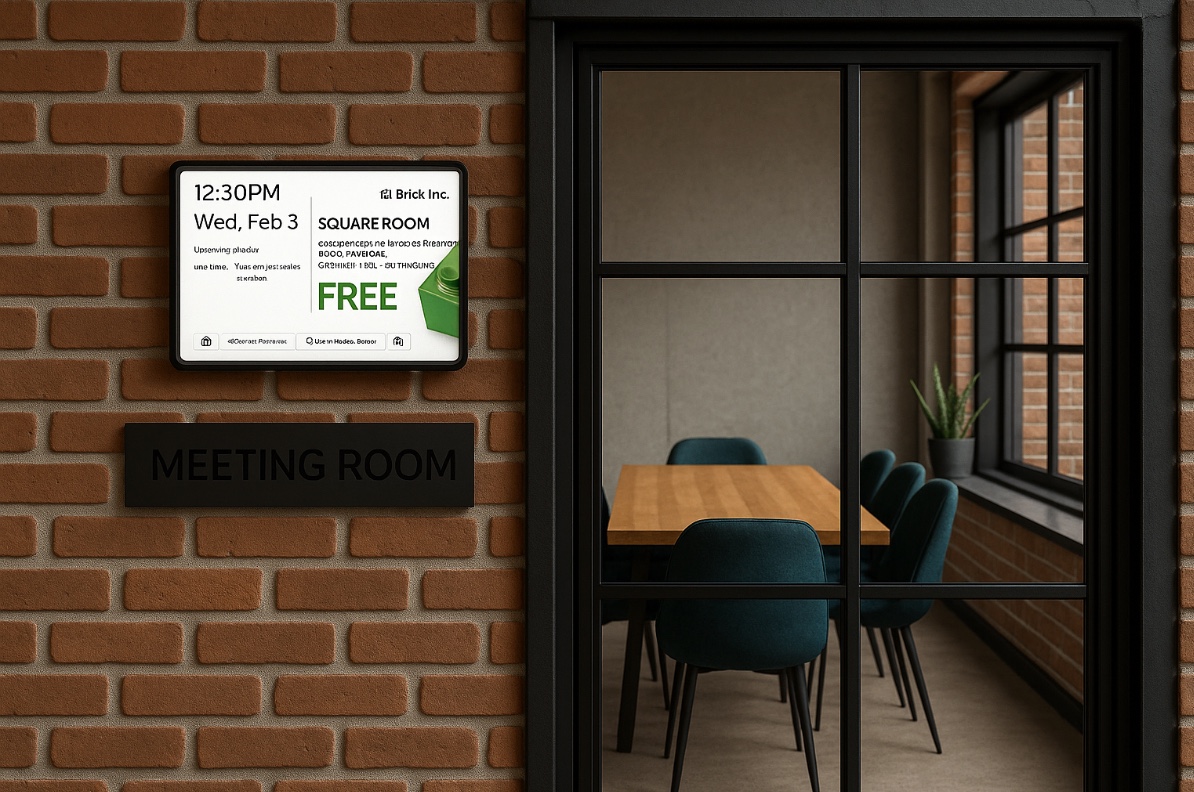 In practice:
In practice:
Picture
a 10-inch touch panel beside every meeting room: the bezel glows green or red, shows your brand colours, and pulls its schedule straight from Microsoft 365 or Google Workspace within seconds of a change. A hot-desking floor plan in the same system lets hybrid staff tap an open seat, see avatars of colleagues nearby, and book on the train before they arrive. If nobody checks into a reserved room, after a grace period, motion sensors automatically free the space so someone else can use it.
What to look for:
- Calendar & ID integration. Real-time sync with Microsoft 365/Exchange, Google Workspace, and SSO so nothing lives in a silo.
- Branding and accessibility. Ability to swap logos, colours, languages, and even lexicon without code; screens should support 15-plus languages and large-text options for inclusivity.
- Right-size hardware. Panels around 10 inches with PoE power (one cable, no batteries) and LED status strips that are visible down the corridor.
- Sensor-aware automation. Built-in or external sensors that confirm presence, auto-check in, and release no-shows.
2. Wayfinding
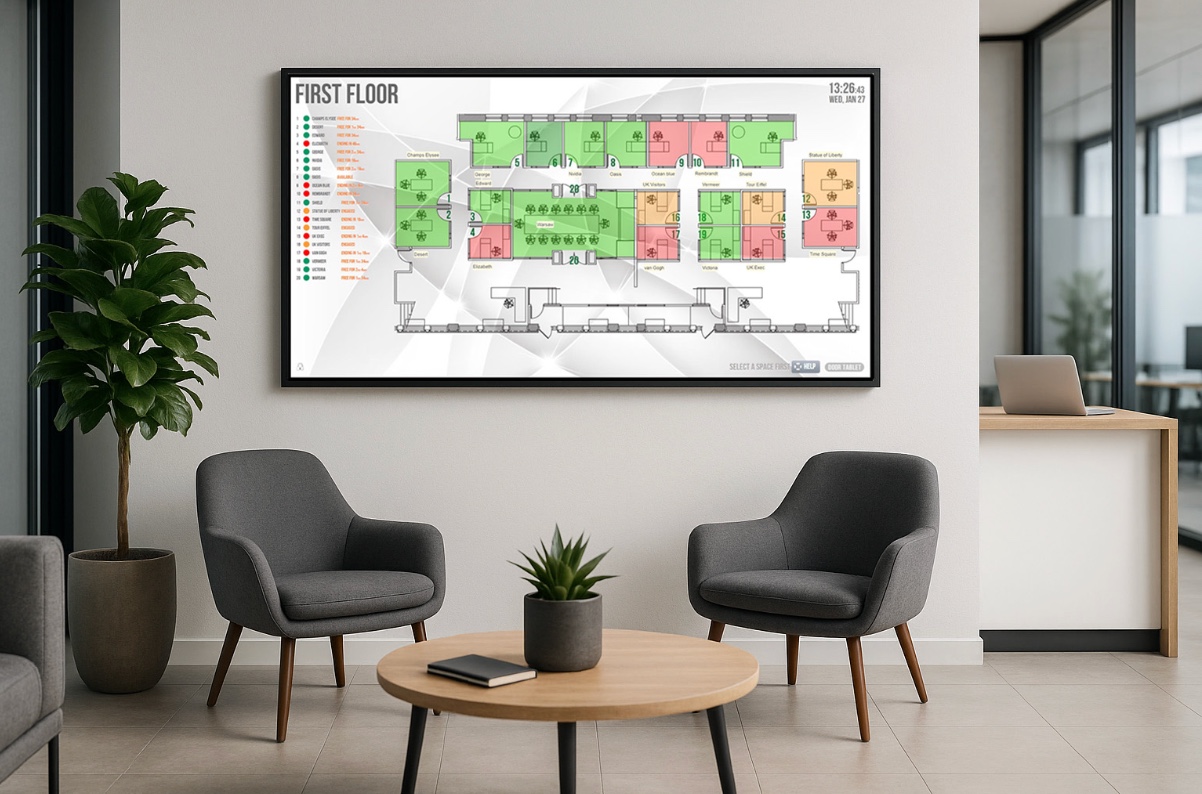 In practice:
In practice:
Imagine arriving at a large corporate campus as a visitor or as an employee who only comes in twice a week – finding the right conference room or a colleague’s desk can be daunting without guidance. A
good wayfinding system displays floor maps on any display in key spaces (lobby, elevators, etc.)
What to look for:
- Live data feed. Maps must pull real-time availability from the booking layer so green spaces are truly free.
- Editable, on-brand floor plans. Drag-and-drop tools to recolour icons, rename zones, and match corporate fonts without calling a developer.
- Scalable hardware. Runs on standard signage players or browsers, not proprietary boxes, so Facilities can repurpose existing screens.
3. Occupancy Sensors & Analytics
In practice:
Motion sensors under desks and in the ceiling register real use. Facilities managers can see the average utilisation of meeting rooms. They can convert underused boardrooms into more huddles and save on the floor rent. Globally,
average office utilisation is still around 35%, down from 64% pre-pandemic, so data-driven changes matter.
What to look for:
- Anonymised data: Sensors count presence, not people’s identities, easing “Big Brother” fears.
- Clear dashboards: Metrics in plain language, like peak occupancy, average meeting size, with export options.
Internal Questions to Ask Before Going to Market
- What employee problems are we solving first? Is the pain finding rooms, managing hybrid seating, or knowing which floors to heat? Rank them before demo day so features don’t distract from goals.
- What experience do we want to create? A friction-free day means bookings under one minute, maps at every decision point, and zero surprises. Translate that into must-have checkpoints.
- How much change can our culture absorb? If people still rely on paper signs, start with room panels and grow. If staff are mobile-first, prioritise an app.
- Who will own the data? Decide early which team (IT, CRE, HR) keeps the dashboards, sets retention rules, and reports wins to leadership.
- What does success look like in 12 months? Maybe it’s 20% fewer no-shows or 15% higher employee satisfaction scores.
These conversations align stakeholders and prevent shiny-object syndrome once you hit the marketplace.
Conclusion: Designing an Unparalleled Employee Experience
Great offices feel almost
magical: the desk you need is open, the room you booked is ready, and the building itself seems to understand when and how people use it. That magic is the result of a well-built workspace-management stack—tools chosen for clarity, trust, and day-to-day ease rather than pure specs.
When employees spend less time hunting for space and more time doing meaningful work, engagement rises and real-estate costs fall.
A workspace management solution like
Door Tablet bundles every layer, room & desk booking, interactive wayfinding, motion-based auto-release, and utilisation analytics into one solution, making that seamless experience easier to deliver.
Build the right stack, and the technology fades into the background while people and ideas move effortlessly to the foreground.
Making the Office Spaces Worth the Commute in 2025
On: May 15, 2025
The Need for a Compelling Return

2025 has been the year of full-time RTO requests from big companies like Amazon or JPMorgan.
Most companies cited that a full-time RTO is necessary because it would help with their culture, collaboration, and productivity. But despite these announcements, many employers didn’t take into consideration that the office is still designed for another era.
Employees now feel they’re being asked to commute just to sit at a desk and do the same work they could easily accomplish from home. It's not a compelling trade-off, and it’s not very encouraging if companies want to maintain long-term RTO success.
For many employees, the office no longer matches how they work best. The post-pandemic shift gave people a taste of autonomy, flexibility, and balance.
Jennifer Moss, workplace strategist and author of
Why Are We Here?, notes that too many companies are trying to execute the office “in the same way that it used to be.”
“You’re still on Zoom, still doing the same work you did at home—but now with a commute,” she explains. Without meaningful changes to space and purpose, the return feels arbitrary, not inspiring.
Another layer that shakes these full-time RTOs policies is trust. John Frehse of Ankura warns that mandating office time without explaining the benefits signals a lack of trust. “You only trust me when I’m in the office?” That unspoken message undercuts employee morale.
And then there are the everyday office frustrations.
Before the pandemic, office life had its fair share of headaches. Employees dealt with open-plan spaces where it was nearly impossible to concentrate because every conversation became background noise. Meeting rooms got double-booked, while others struggled to find a space or even schedule one directly. Desks were either too limited or not personalised, and the layout made it hard to find a quiet corner or a collaborative space that supported productive individual time or team interaction.
Fast forward to 2025, and many of these issues still linger. Meanwhile, employee expectations have grown. People now expect environments that support both
in-person connection and individual productivity, along with seamless integration of digital tools.
There is a deeper issue beyond outdated layouts and logistical frustrations: control.
When employees work from home, they’re in charge of their environment. They can choose how, when, and where they work best—whether that’s total silence, a standing desk, or a mid-afternoon break that recharges them. In contrast, many office spaces strip away that autonomy. You're tied to a fixed desk, have limited privacy, and have rigid routines.
This loss of control directly affects job satisfaction. This
study shows that comfort and a sense of choice significantly boost performance and well-being. When people feel their environment is working with them, not against them, they're more engaged, more productive, and more likely to view the office as a valuable part of their working week. Without that, returning to the office starts to feel more like a burden than a benefit.
“Office-space preferences can push employees away from on-site working, influencing their hybrid-work preferences.”-
Lila Skountridaki
Giving employees the control they need, not just cubicles
So, what does a workplace look like when it supports control instead of removing it?
Employees want to decide how, where, and when they work best. That doesn’t mean a free-for-all; it means designing systems and spaces that enable flexibility without descending into chaos.
And this is where
tech and culture meet.
Because when culture says,
“we trust you”, and technology says,
“we’ve got the tools to support you”, employee autonomy becomes possible. Not just over tasks, but over environments, schedules, and energy.
Tech can’t fix culture, but it can remove friction
That sense of control is what makes coming into the office feel worth it again. When people have ownership of their time and environment, it leads to better focus, stronger collaboration.
1. Smart meeting room booking
Say goodbye to calendar chaos. Intelligent
room booking systems integrate with calendars, detect occupancy, and release unused spaces. This prevents bottlenecks and ghost meetings—an issue that used to plague large firms pre-pandemic.
Microsoft reported that
20% of meeting rooms were reserved but never used in pre-COVID offices. With hybrid now in play, automation can bring balance and fairness to space usage.
2. Desk booking & workplace wayfinding
Flexibility is only empowering when it’s organised.
Desk booking apps let employees reserve their spot, see where their team is sitting, or find quiet zones based on mood or task. It also means that Facility Managers can track usage and adapt layouts dynamically.
3. Noise zoning & adaptive spaces
Open-plan designs aren't inherently bad, but they need structure. Sound masking tech, acoustic sensors, and smart zoning allow offices to flex between collaborative buzz and focused silence. Think of it as giving people a volume knob on their day.
4. Hybrid-ready AV and meeting equity
“Can you hear me?” shouldn’t be the soundtrack of a hybrid call. High-quality microphones, auto-framing cameras, and inclusive layouts ensure remote participants feel equally involved. Tools like Zoom Rooms and Microsoft Teams Rooms now support intelligent framing and transcription, making the office a place where hybrid meetings work.
5. Smart signage and spontaneous interaction
Use real-time digital signage to promote the community: highlight who's in today, upcoming events, or ad-hoc lunch-and-learns. Encourage spontaneous coffee chats, project brainstorms, or cross-team mixers that remote work can’t replicate.
Culture doesn’t live in code, but it does need space
Yes, culture is built by people. But it also needs the right conditions to thrive. Offices must be designed for belonging, mentoring, casual exchange, and moments of creativity that are hard to schedule but powerful to experience.
In other words, giving people a
reason to show up.
“When we’re trying to get people back into the office, we still are executing the office in the same way that it used to be. We just can’t jam the toothpaste back in the tube.” - Jennifer Moss
This doesn’t require a full rebuild. Even small, intentional changes can go a long way:
- Curating zones for heads-down work, collaboration, and casual connection
- Using sensors and occupancy analytics to understand how spaces are used
- Making social spaces visible, inviting, and part of the workflow
- Protocols for shared spaces. For example: “Quiet hours in this zone from 10am–12pm.” Or “Headphones only for music or video.”
When people have the freedom to choose
how and
where they work within the office, engagement goes up, and resentment fades.
“Reduce the pace and give people that mental adjustment time that is needed genuinely, to take care of their lives before you change
[their lives].” - Sujay Saha
Takeaway: The Commute Must Pay Off
In 2025, the commute has become symbolic. Employees aren’t just travelling to a building, they’re deciding if it’s worth it.
If they arrive only to spend the day on video calls or struggle to find a quiet spot, that choice feels like a burden, not a benefit. A workplace that also offers a professional, client-ready environment can make a real difference.
When employees know they have access to impressive spaces for both internal collaboration and hosting external meetings, the commute feels more worthwhile and productive.
But if the office is a place where real collaboration happens, where ideas spark and relationships grow, then the journey makes sense.
That’s what the best RTO strategies understand: people want to feel that their presence matters. That showing up adds value, not just for the company, but for themselves.
Is the Open Office Layout still relevant in 2025?
On: April 22, 2025
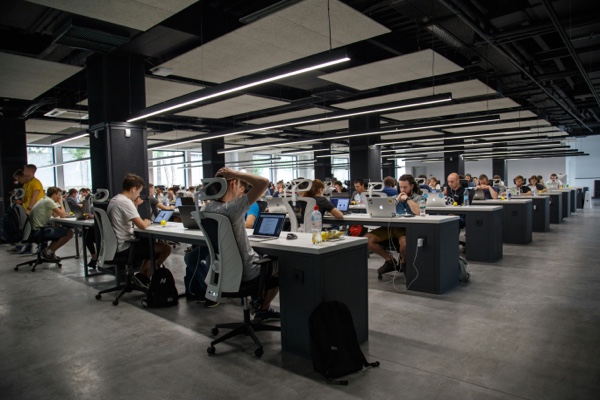
A decade ago, open-plan offices seemed like the future of work. Companies wanted to break down silos, boost collaboration, and reduce real estate costs. For a while, it worked—or at least, it looked like it did.
But by 2025, we will have enough data to call it:
the open office layout isn't delivering on its promises.
It's hurting productivity, employee satisfaction, and even the motivation to come into the office.
Let’s start with productivity.
A Harvard study found that when two major firms transitioned to an open layout, face-to-face interactions dropped by 70%, while digital communication spiked. The open space, instead of encouraging spontaneous collaboration, pushed employees to retreat into digital silos. This counterintuitive result is a red flag for anyone designing spaces meant to foster teamwork.
There is also a lack of privacy in these types of offices. Open-plan offices often lack designated quiet spaces for focused work. This can lead to employees feeling overstimulated and unable to concentrate on their work.
A study by Oxford University found that employees in open-plan offices reported feeling a lack of control over their environment, which can further hinder focus and productivity.
It’s estimated that open environments lead to a loss of
86 minutes of productive work per day. That’s more than 7 hours a week, per employee.
The negative effects don’t stop at performance. According to
Gensler, only
41% of workers in open offices feel they can concentrate effectively. And a third report needs to leave the office entirely to get meaningful work done. That can negatively influence job satisfaction and retention.
The
chart below indicates that individuals in open-plan setups experienced significantly more audio and visual distractions on-site, on average. This pushes them to choose to work from home.
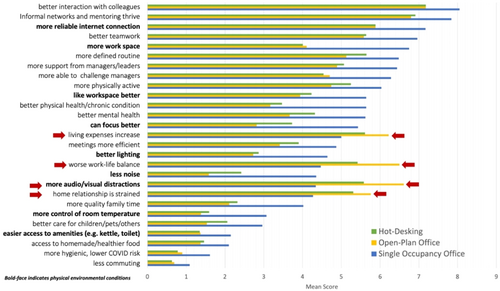
Health and well-being are also at stake.
Studies show that employees in open-plan offices take
62% more sick days, possibly due to easier transmission of illnesses and elevated stress levels.
The Link Between Office Design, Job Satisfaction, and Attendance
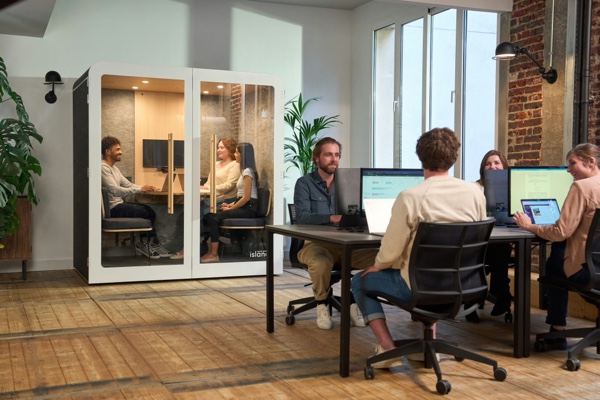
One of the clearest lessons from the pandemic-era shift to remote and hybrid work is this: employees are more willing to come into the office when it offers something they can't get at home.
That doesn't mean ping pong tables and free snacks. It means a space that supports their work and makes their day easier, not harder.
Activity-Based Working (ABW) is one model that meets this need. Unlike the open office, ABW provides a variety of work settings—quiet zones for deep work, breakout rooms for collaboration, and phone booths for private calls. Employees choose the space that fits their task. According to
CBRE,
over 53% of companies are adopting this model because it boosts both productivity and satisfaction.
ABW gives employees control, and that control increases their engagement. A
study comparing office layouts found that satisfaction was highest in single offices, followed by ABW environments, with traditional open plans scoring lowest. It's not about eliminating collaboration; it's about offering choice.
Smart Layouts Meet Smart Tech
A shift away from open offices doesn’t mean designing in the dark. Sensors and analytics tools give facility managers real-time data on how space is used.
Motion sensors, for example, can show which meeting rooms are actually being used and which sit empty, helping teams manage bookings more efficiently. This data can be used to fine-tune layouts, move resources, and better allocate desks and rooms.
Testing and iterating with real data, organisations can develop a responsive, flexible office that encourages people to return, not because they have to, but because they want to.
Should We Ditch Open Layouts Entirely?
Open spaces still have a role to play, but that role needs to be clearly defined. In creative industries or innovation hubs, open layouts can support idea-rich environments. For short-term project teams, a shared, open workspace might foster camaraderie and quick communication. But these should be the exception, not the rule.
Most knowledge workers need both collaboration and concentration in their day-to-day work.
Open-plan layouts also fall short when it comes to hosting clients. They rarely offer the privacy, quiet, or professional atmosphere needed for external meetings. A well-designed office should support both internal collaboration and create an environment that’s impressive and functional for visitors. Spaces that can flex between focused work, team collaboration, and client-facing meetings are key to making the office a true asset, not just for employees, but for the business.
A mixed layout that includes open lounges, enclosed meeting pods, quiet rooms, and reservable desks allows people to flow between work modes without sacrificing comfort or focus.
In 2025, office design should no longer be about fitting the most desks into the least space. It should be about aligning physical environments with business goals, employee expectations, and data-backed insights. The open-plan layout was a bold experiment. Now, it’s time to take what we’ve learned and design spaces that truly work.
Final Thoughts: It’s Time to Rebalance the Office
We’re not saying open offices are evil. They had their place. But as the research and employee feedback roll in, it’s clear that
open plans alone can’t support modern work. Offices need to be places of purpose: where collaboration is easy, deep work and privacy are protected, and coming in feels worthwhile.
The good news? We have the tools to make it happen. With data from sensors, feedback from employees, and flexible tech like desk booking systems, we can build better workplaces. And that starts with letting go of the idea that one big room fits all.
How Lagging Workplace Tech Is Hurting Your Return-to-Office Success
On: April 8, 2025

Everyone’s focused on bringing people back to the office. But here’s the thing:
if the workplace tech doesn’t work, neither will your return-to-office plan.
In 2025, some companies invested in new desks. Others repainted the walls. A few even installed fresh coffee stations. But when employees returned, they were met with an old-fashioned meeting room booking process, double-booked spaces, and confusing desk booking systems. This can influence employees to choose to stay home the next time.
The truth is,
bad or outdated tech is now one of the biggest blockers to successful RTO efforts. Let’s unpack what’s going wrong—and how to fix it.
Why Employees Still Aren’t Coming In
You can mandate office days, redesign the layout, and run all the engagement surveys in the world. But if the office experience is broken, especially the tech part, people will opt out. And they are.
According to
a 2023 Gartner report, over 40% of hybrid workers cite poor in-office technology as a primary reason for avoiding their company’s physical workspace.
McKinsey also found that employees in workplaces with seamless digital experiences are 1.8x more likely to report high job satisfaction.
So what’s going wrong?
Four Tech Red Flags That Keep People Away
1. Desk booking systems that cause chaos
Imagine reserving a desk for Wednesday only to find someone else sitting there—or worse, the system crashed before you got in. Inconsistent or unreliable desk booking software breaks trust.
Real comment from an employee in a Leesman Index study
“I’ve stopped booking desks because it’s always a gamble. I just stay home if I want to focus.”
2. Meeting room tablets that never seem to work
Meeting room tablets are supposed to solve problems, not create them. But when they’re out of sync with calendars, slow to respond, or misreport room availability, people waste time hunting for spaces.
According to CBRE,
63% of employees have been unable to find a room despite seeing multiple empty ones—a sign of system breakdowns, not space shortages.
3. No visibility into who’s in the office
Employees don’t just come in for the coffee machine, they come for people. But without a system that shows who’ll be in, office days can feel lonely.
4. Tech that feels outdated and out of touch
Slow Wi-Fi, clunky logins, poor video conferencing setups—these all send the message: this isn’t a serious workspace. And that’s a deal-breaker when home setups are now better than ever.
So What Should Workplace Tech Do?
Here’s what today’s workforce expects from the tech that powers their in-office experience:
- Be seamless – One tap to book a desk. Real-time room availability. Auto-cancellation if no one shows up.
- Be reliable – No outages, syncing issues, or confusing user interfaces.
- Be insightful – Offer facilities teams real-time data on usage, trends, and comfort levels (think temperature, IAQ, occupancy).
- Be social – Help people coordinate days in, see who's around, and plan collaboration opportunities. Support team office days and make it easy to reserve spaces like meeting rooms and project areas.
- Be responsive – Update based on feedback, usage data, and workplace patterns.
And most importantly,
tech should help, not hinder—the reason people came in.
Give your employees a reason to return
No one wants to commute just to fight for a desk or troubleshoot a meeting room display. Employees will come back, but only if the office helps them work better than they can at home.
The most effective full-time RTO strategies
don’t lead with mandates. They lead with experience. And that experience starts with intuitive, dependable, human-first technology.
Let’s stop blaming employee resistance and start looking at the systems we’ve built for them.
Because in the end, return-to-office success isn’t about compliance—it’s about delivering a better workplace experience, powered by tech that works.
How to handle No-Show Meetings
On: April 1, 2025
As offices welcome more foot traffic in the post-COVID era, challenges like no-show meetings are making a noticeable comeback. When meeting rooms remain empty, it's not just a scheduling hiccup - it directly impacts your bottom line by costing you money on unused space and overhead.
We’ll explore the everyday challenges of no-show meetings in modern workspaces. Along the way, we’ll share practical strategies and smart tech solutions, like Door Tablet, to help you optimize your meeting spaces.
The Common Scenario of No-Shows and Abandoned Bookings
Employees often book meeting rooms only to decide later that a quick email or phone call would suffice, or they simply forget to cancel the booking. This results in empty rooms and wasting valuable time as people scramble to find available space when they need it most.
“When meeting rooms remain empty, it costs you money because you are still paying for the unused space”
The Cost of Booked but Unused Meeting Rooms
Let’s do a math exercise
Let’s say your company rents an office space in central London (£150 per square foot; source: K2Space). Within this prime location, you have 1 standard small meeting room, designed to comfortably accommodate 4 people, taking up approximately 100 square feet (source: Workspace)
100 sq ft * £150/sq ft per year = £15,000 per year in rent just for the physical space.
Daily Cost: £15,000 / 260 working days ≈ £57.69 per day or £7.21 per hour, assuming an 8-hour working day across 260 working days per year.
Now consider this common scenario: a weekly team meeting is scheduled in the room, but no one shows up. The room remains booked and unavailable to others, yet entirely unused.
While it may seem minor, the cost of that one-hour weekly no-show adds up to:
£7.21/hour × 52 weeks = £374.92 per year – per room.
Multiply that across five similar meeting rooms, each experiencing a single unused booking per week, and the annual cost rises to:
£374.92 × 5 rooms = £1,874.60 per year
These figures account only for rent. But the cost of empty meeting spaces goes beyond just wasted square footage. You're also paying to heat, cool, and light rooms that no one is using.
When meeting rooms are booked but remain unused, they quietly drain your budget—while limiting the flexibility and efficiency of how your office space is utilised.
So how do we avoid this situation?
1. Define Clear Booking Rules
Think about it: when an employee neglects to show up for a meeting, that empty room isn’t just a vacant space; it’s a potential moment for collaboration that’s lost. To make sure everyone is on the same page about how to use the meeting room spaces, create Booking Rules for everyone who is coming into the office.
Policies to Consider:
- Set Maximum Booking Durations: Limit the length of each reservation (e.g., two hours per meeting) to ensure equitable access and prevent long, unproductive blocks.
- Implement a Cancellation Window: Require cancellations to be made at least 15–30 minutes before the meeting start time to free up space for others.
- Mandatory Check-Ins: Introduce a check-in system that confirms attendee presence. If the check-in isn’t completed within a set time, the room is automatically released.
- No-Show Penalties: Establish consequences for repeated no-shows, such as temporary suspension of booking privileges or departmental accountability measures.
- Recurring Booking Guidelines: Review recurring meeting bookings periodically to confirm they are still necessary, avoiding “ghost meetings” that waste valuable space.
These practices can be easily implemented with clear guidelines. Make sure to communicate the rules to everyone, integrate them into your booking system, and monitor compliance.
How do you get the whole company to actually follow them?
When you roll out these rules, make sure they’re not just “rules” that are imposed top-down. They need to be integrated into your company culture - think of them more like friendly guidelines than hard and fast regulations.
It’s not about control, it’s about respect.
Respect for space, respect for each other’s time, and respect for keeping things running smoothly.
Instead of viewing meeting spaces as personal reserves, they should be seen as shared resources. When everyone gets on board with this idea, you’ll see a shift - people will be more thoughtful when booking rooms and more considerate when they no longer need them, keeping things open and accessible for everyone.
2. Use a Meeting Room Management Solution
The technology behind your meeting room management solution can make or break how employees view meetings. If the process is not easy, you're likely to see more empty rooms or double-bookings because people waste time navigating a clunky system.
Every minute counts for those who choose to come into the office - they're there to be productive and get things done.
A system like
Door Tablet offers a seamless solution that helps prevent wasted space by ensuring every booking is validated and up-to-date.
Door Tablet provides real-time availability updates so employees can instantly see which rooms are free, eliminating the guesswork and last-minute scrambling for space.
Key features include:
- Automated Release: The system prompts attendees to check in as soon as the meeting starts, automatically releasing the room if no one checks in within a set timeframe.
Important Mention: Door Tablet motion sensors can be added to automate the check-in process. Placed in each room, they automate check-in when someone enters and release the room if it stays empty, removing the need for manual tablet interaction.
- Real-Time Integration: Door Tablet syncs with major calendar systems, ensuring that reservations are always current and preventing double-bookings. This seamless integration minimizes scheduling conflicts.
- Automated Reminders: Timely notifications remind participants of upcoming meetings, reducing the likelihood of no-shows.
- User-Friendly Interface: Designed for simplicity, Door Tablet makes it easy for anyone to reserve, extend, or cancel bookings on the fly - ensuring even the least tech-savvy employees can navigate the system effortlessly.
Empower your on-site teams with technology that simplifies navigating the office and managing meetings, making their time in the office more enjoyable.
The Takeaway
Ensuring your meeting rooms are used efficiently isn’t just about setting rules - it’s about fostering a culture of accountability. When employees understand that rules like booking limits, cancellation windows, and check-ins aren’t there to create extra work, but to help everyone, they’ll be more likely to respect them. A shift in mindset from seeing rooms as personal reserves to shared resources makes all the difference.
Pair this cultural change with smart tech like
Door Tablet, which automates check-ins, sends reminders, and updates availability in real-time, and you’ve got a system that helps employees stay on track without hassle.
With the right tools and the right mindset, you’ll get more out of your office space, keep meetings on schedule, and ensure those rooms are used when they’re needed most.